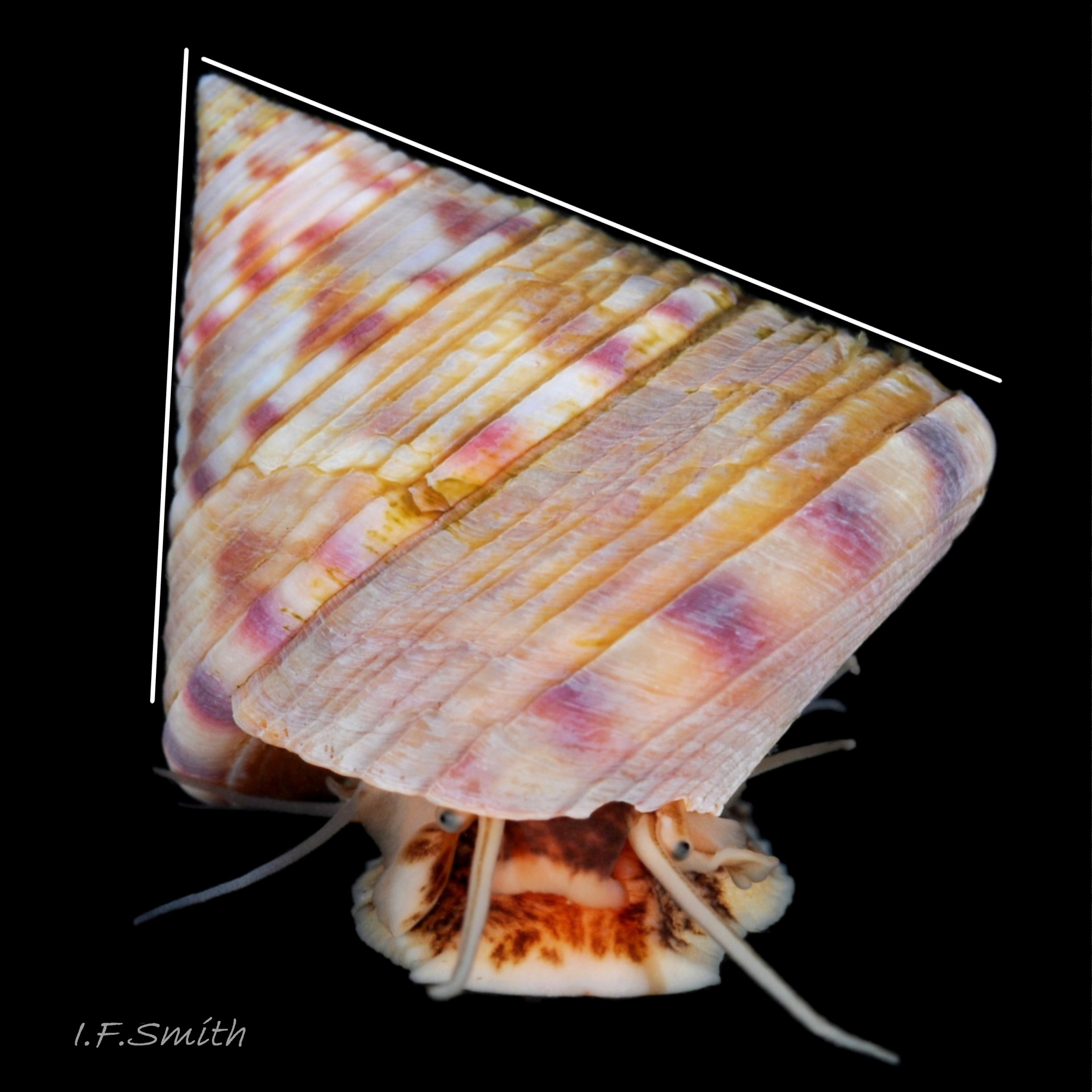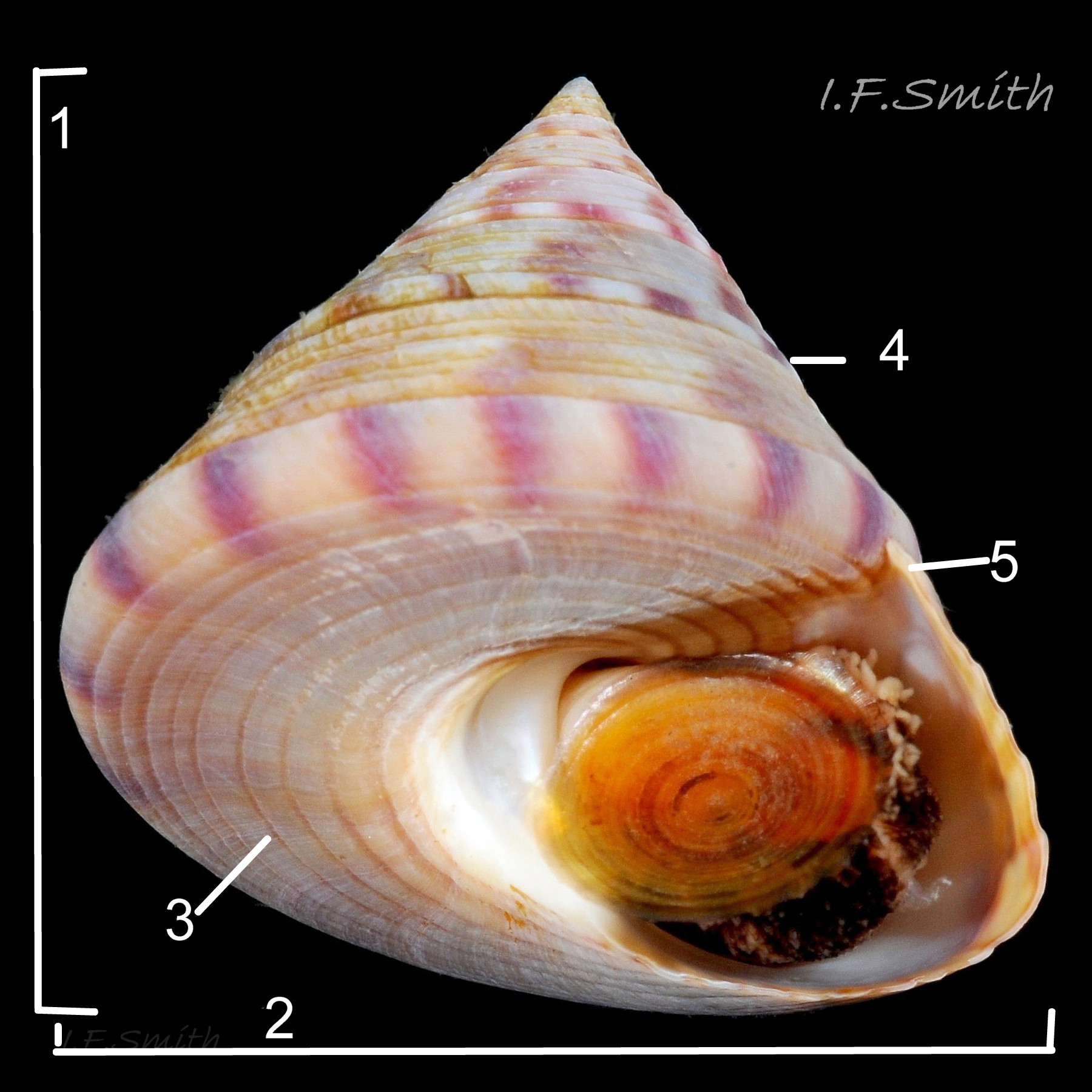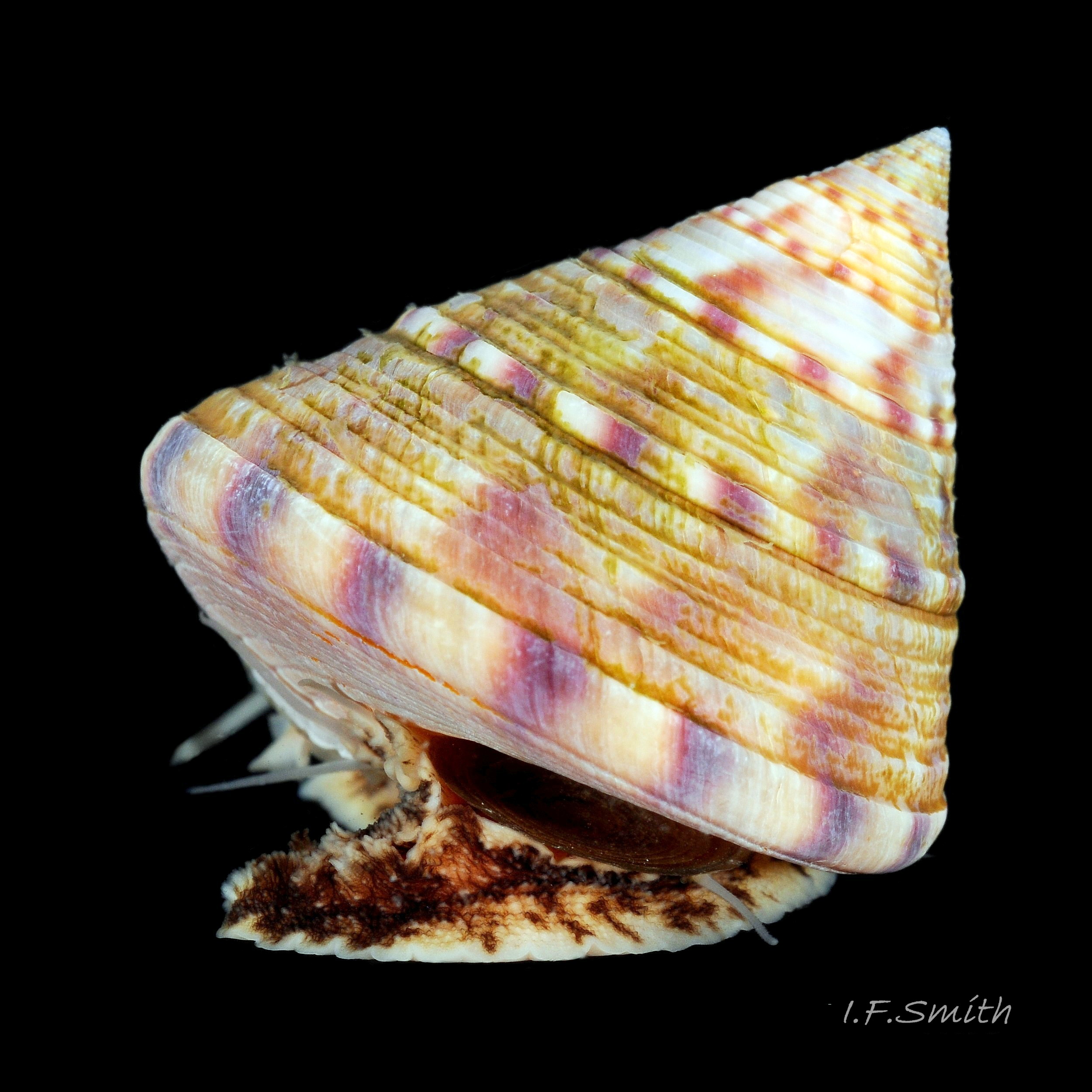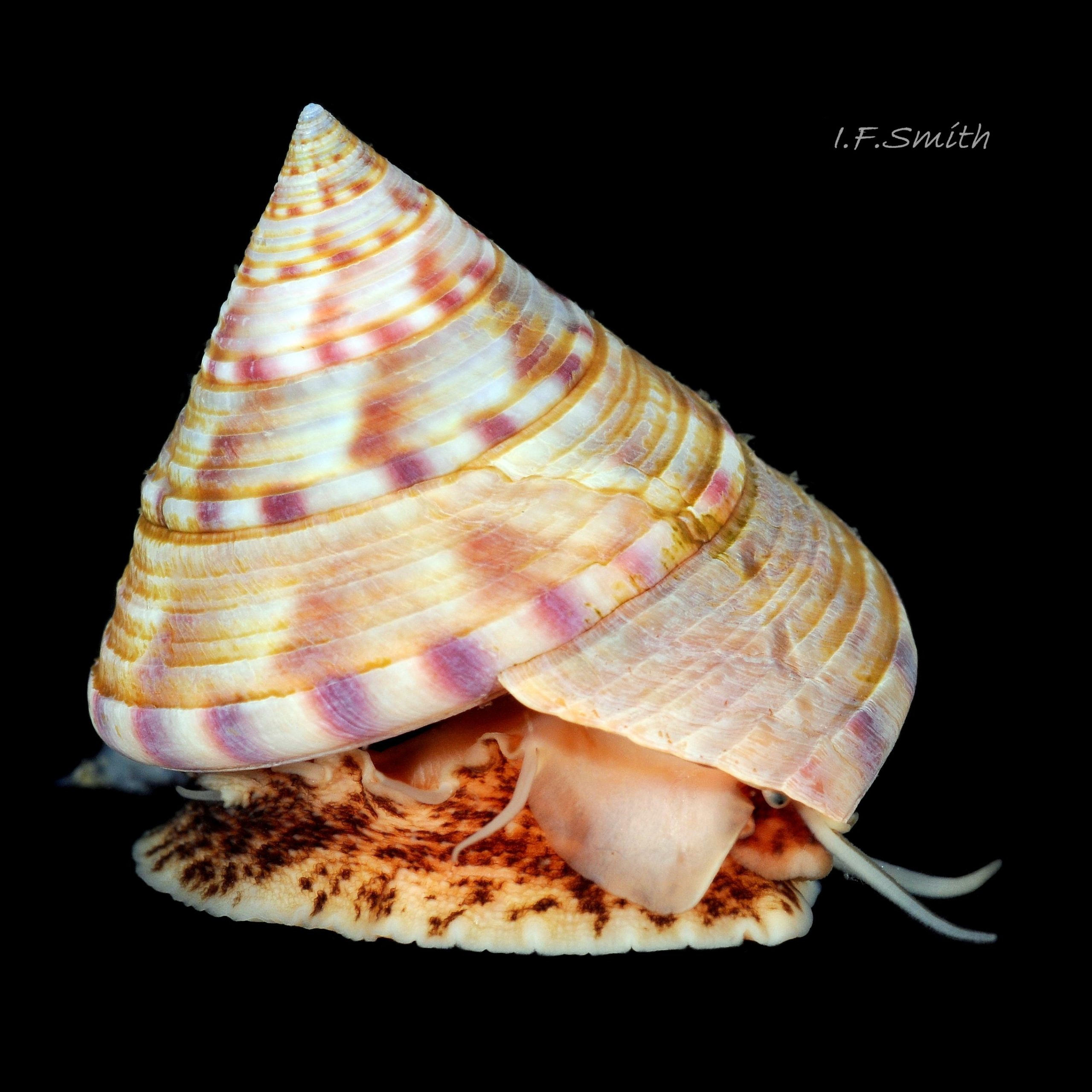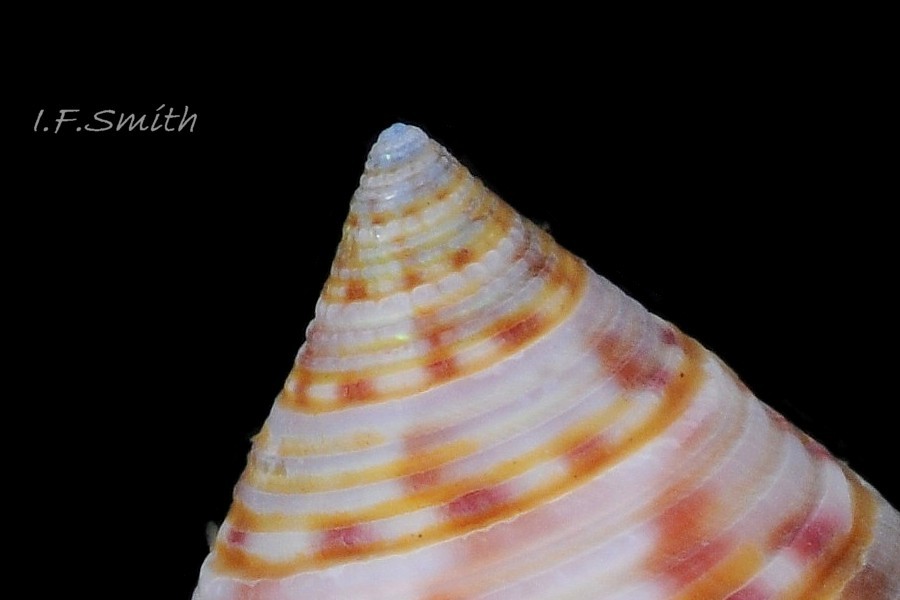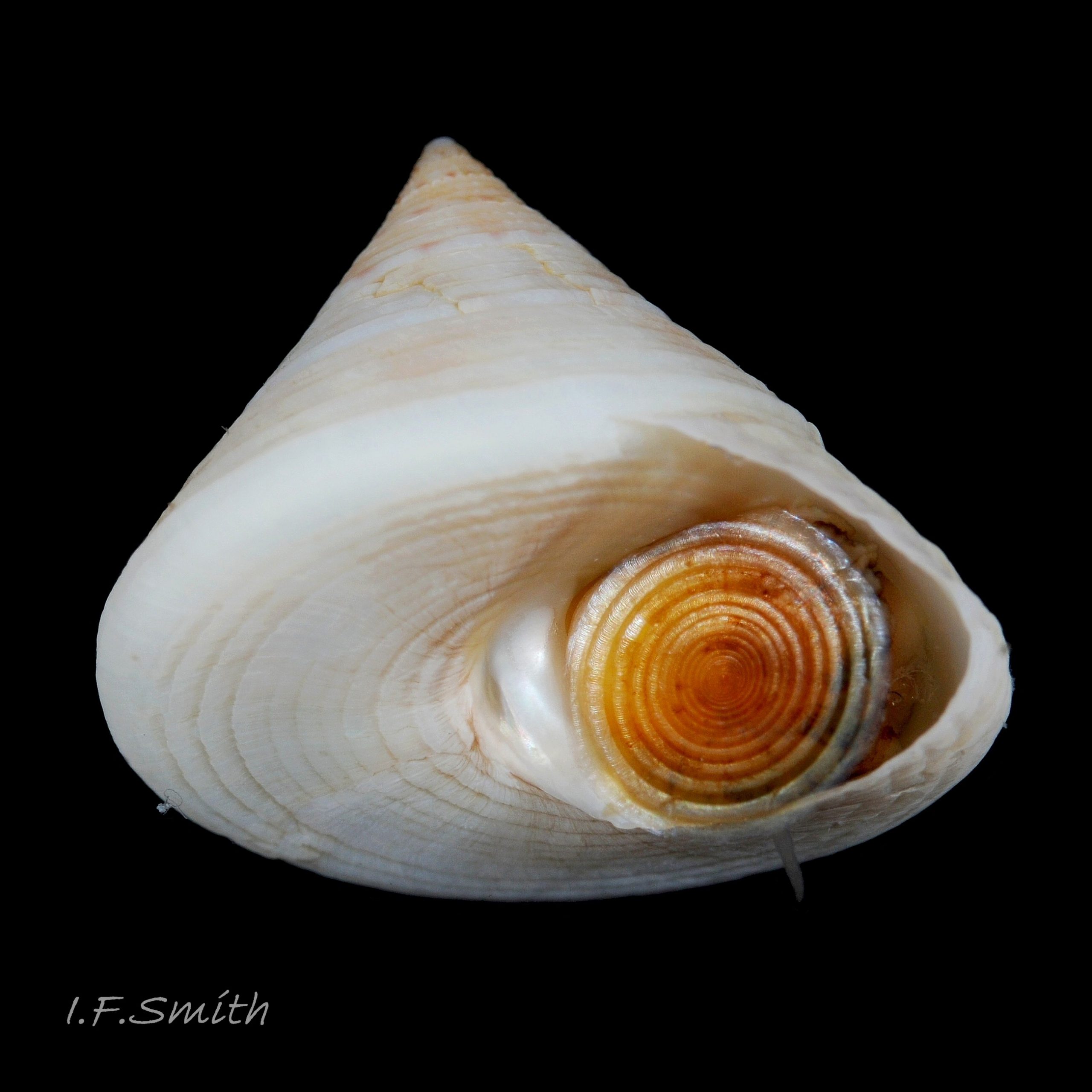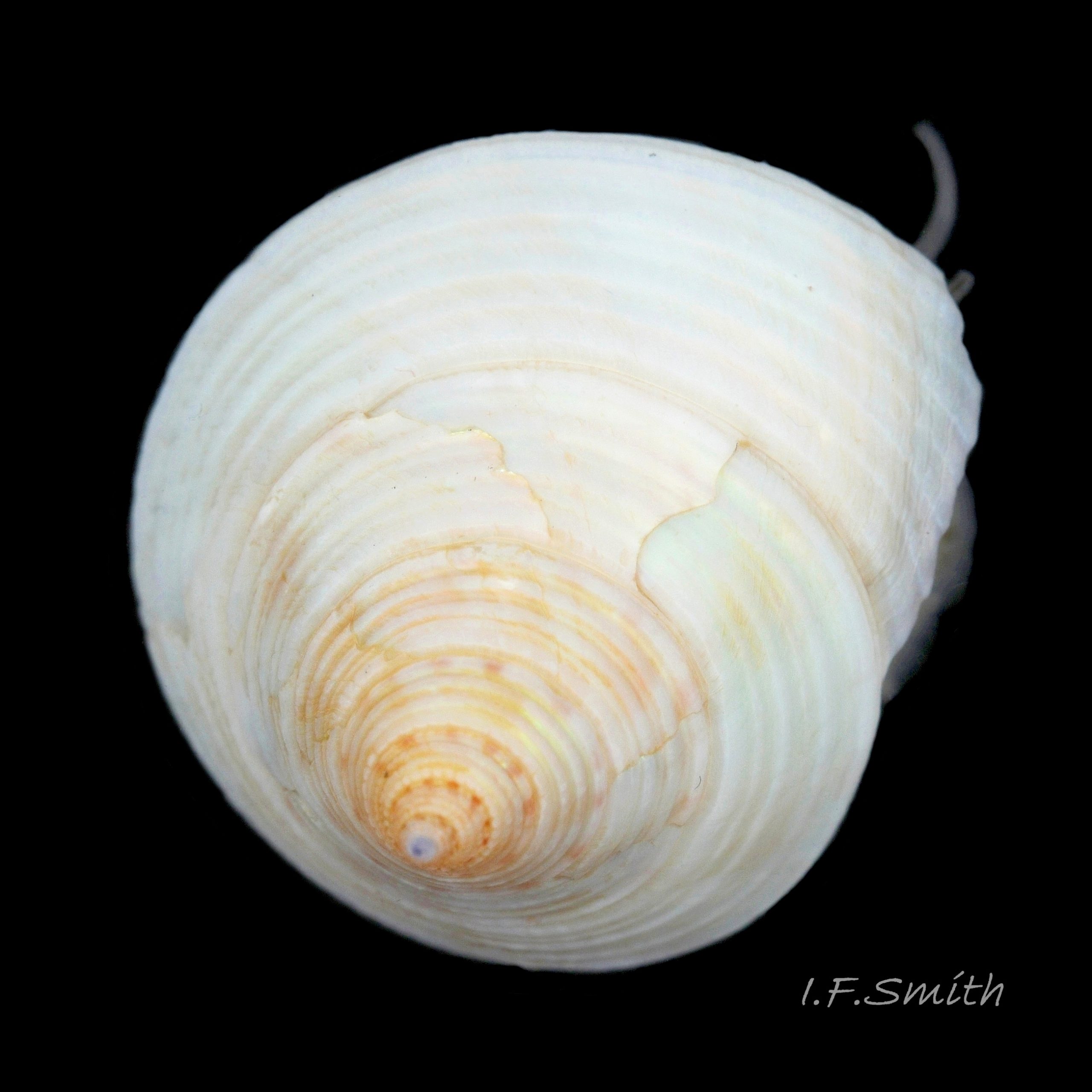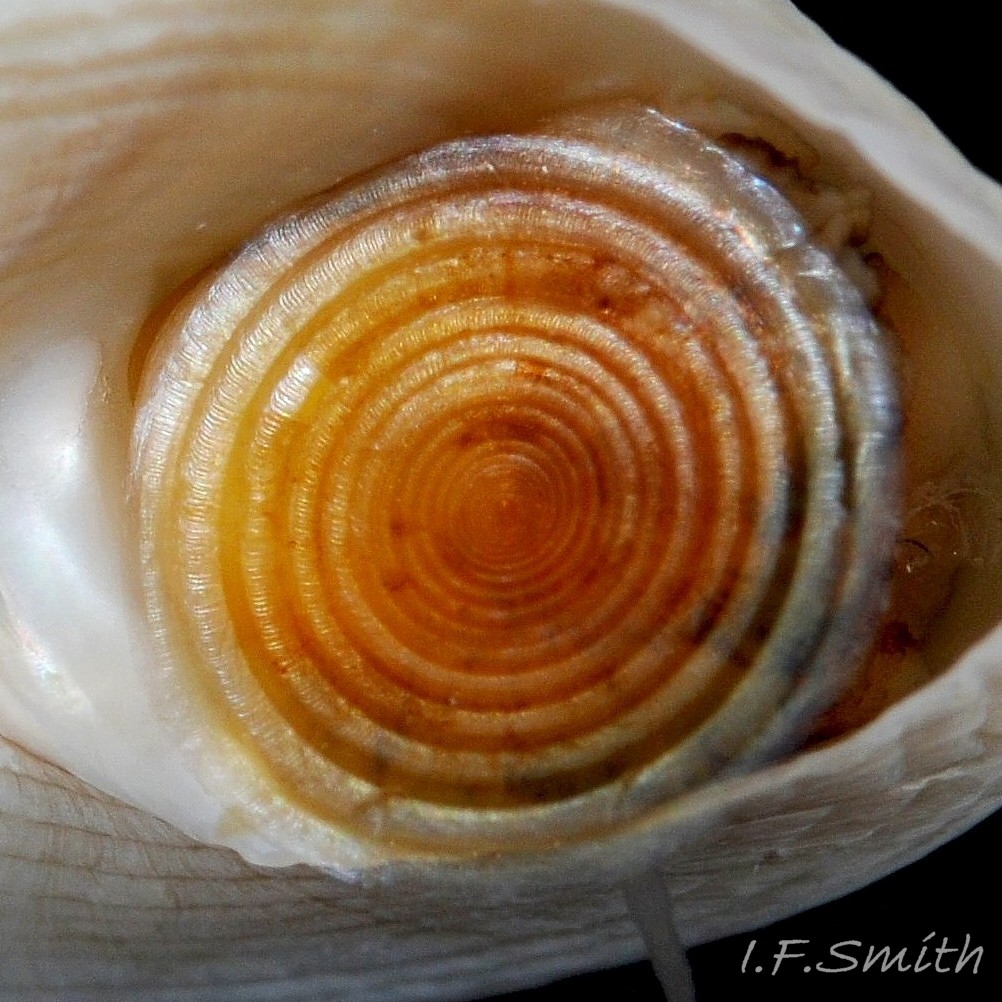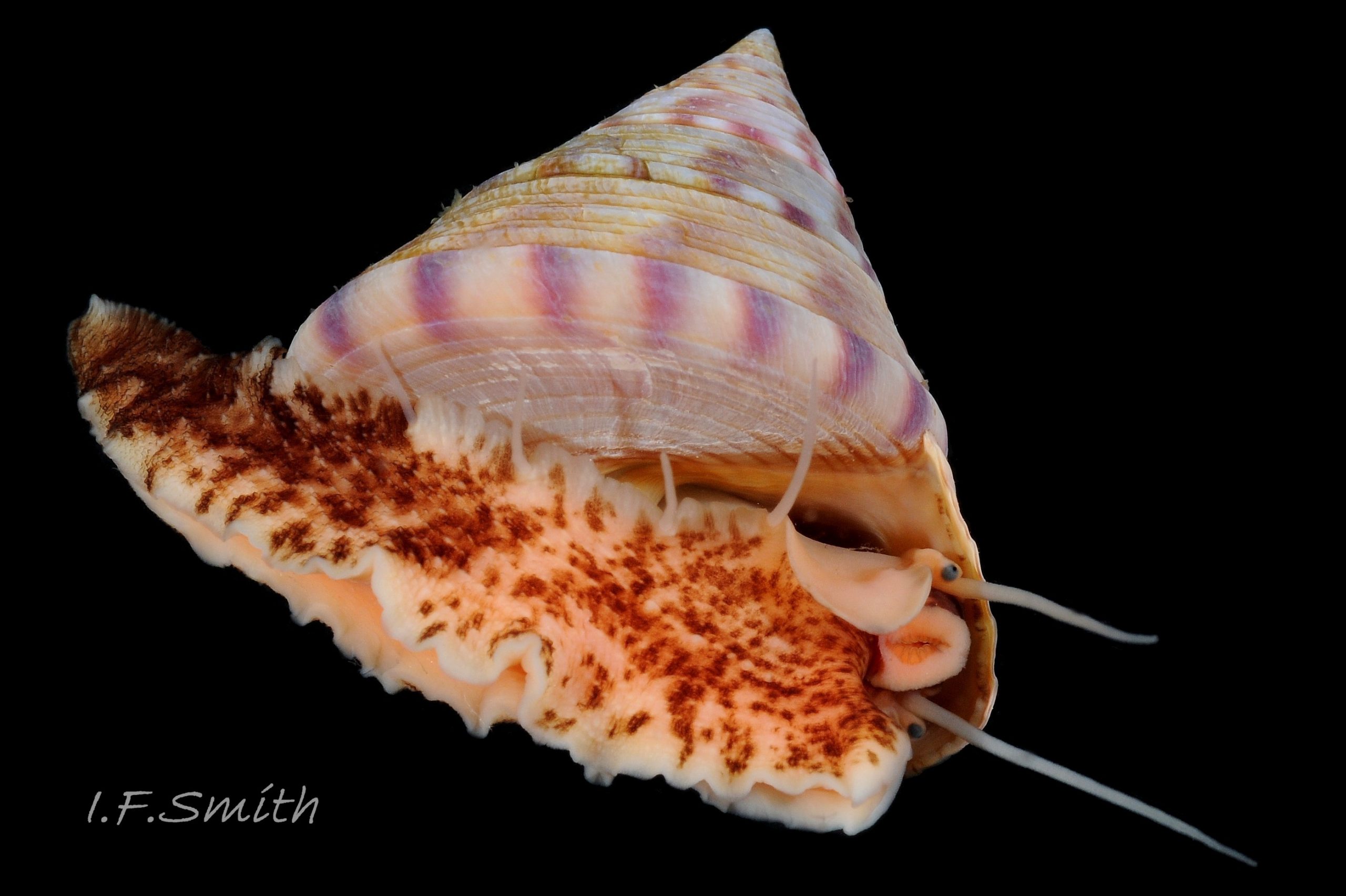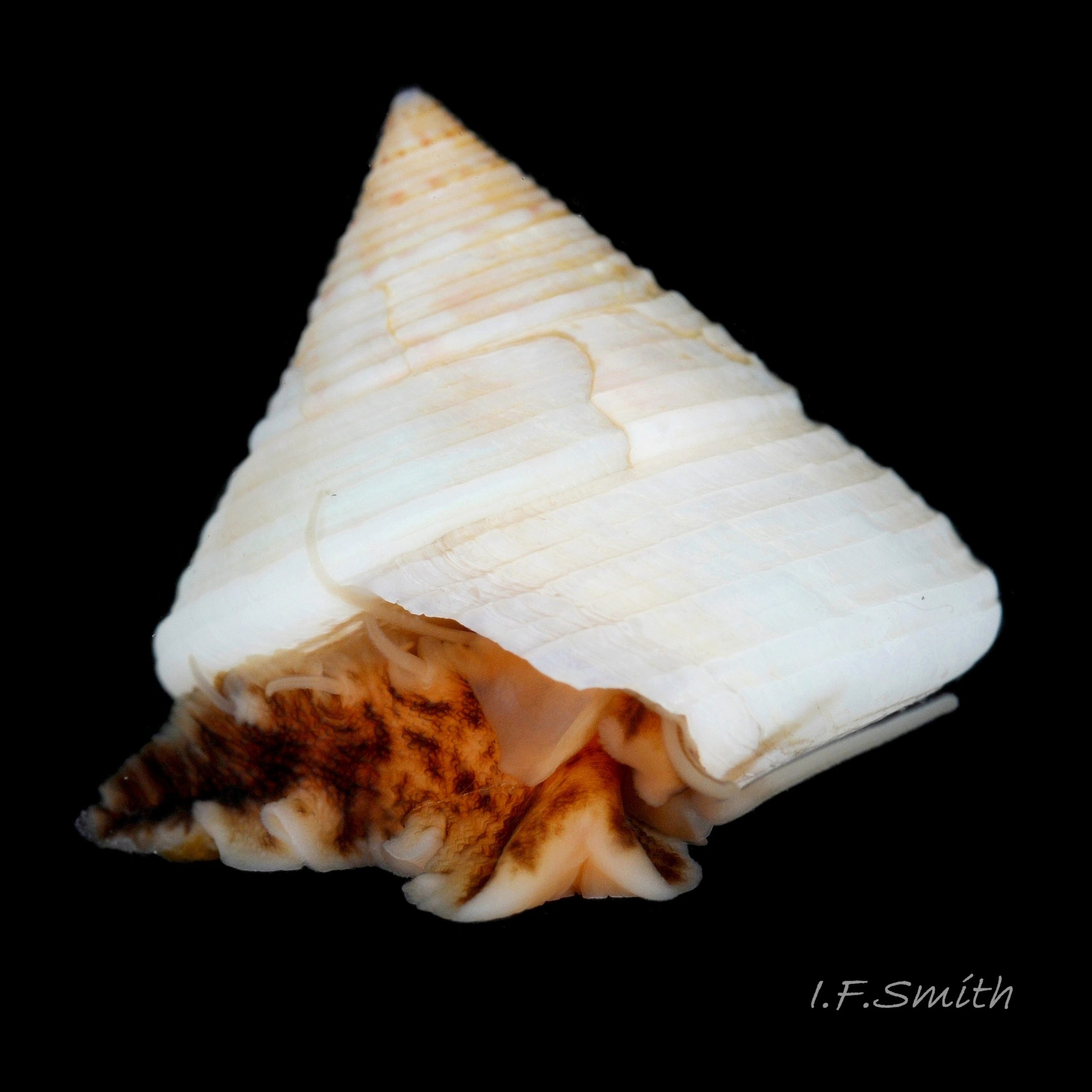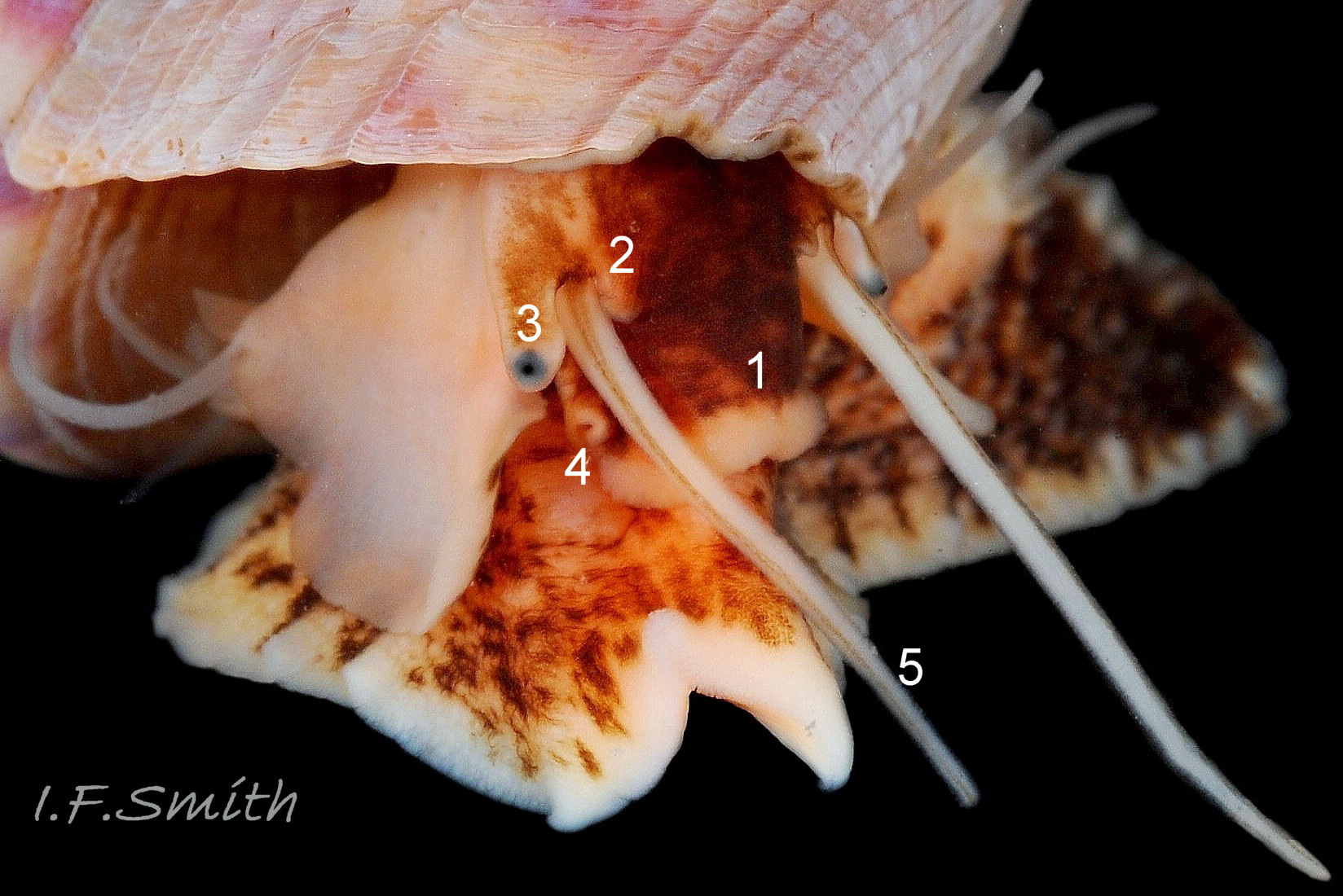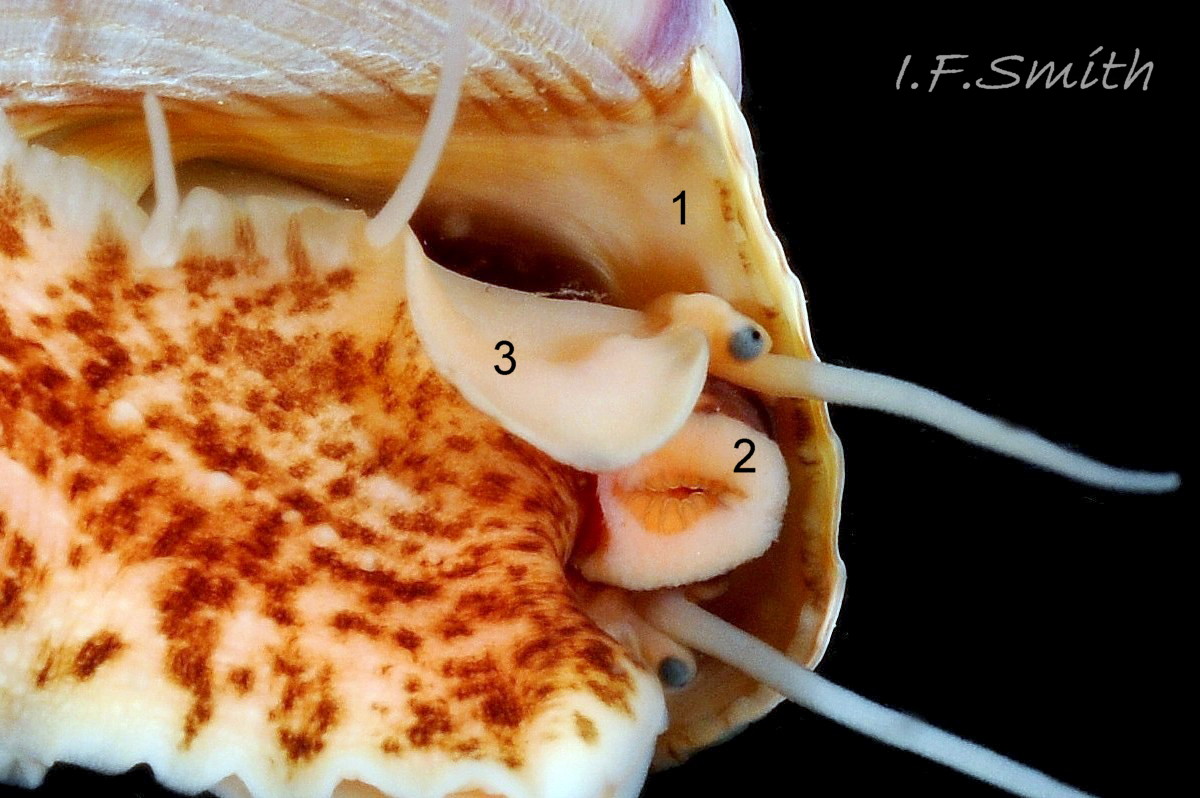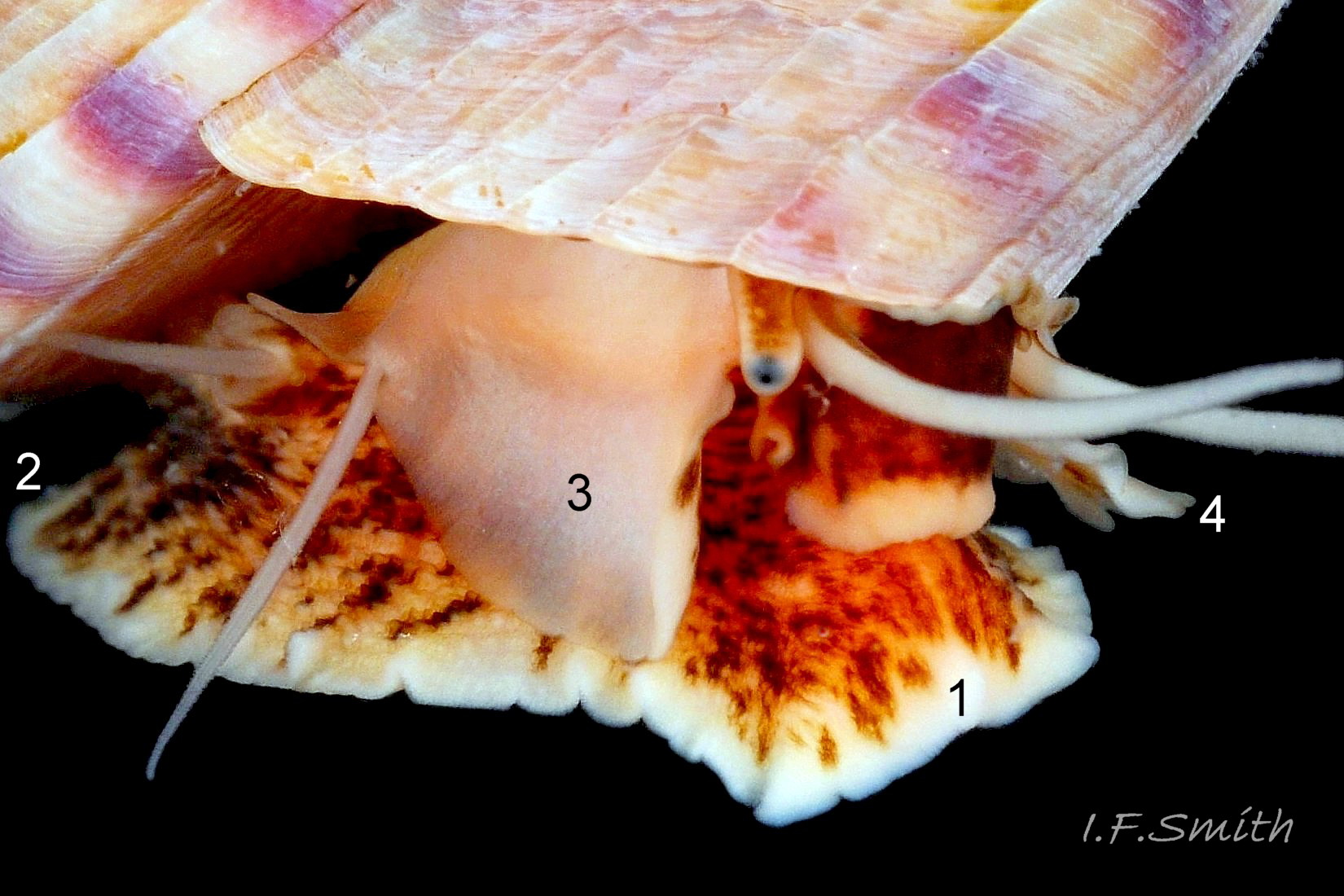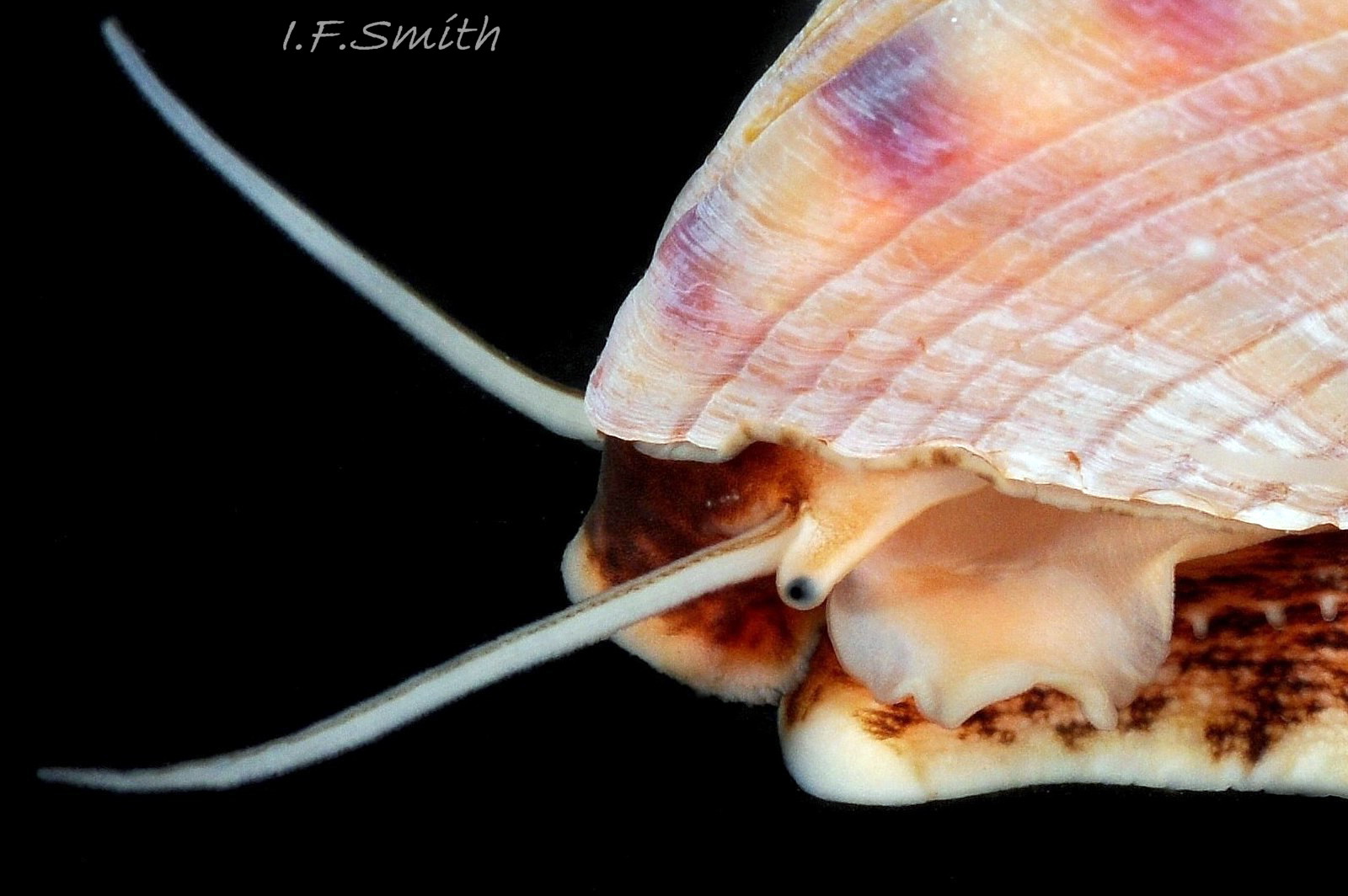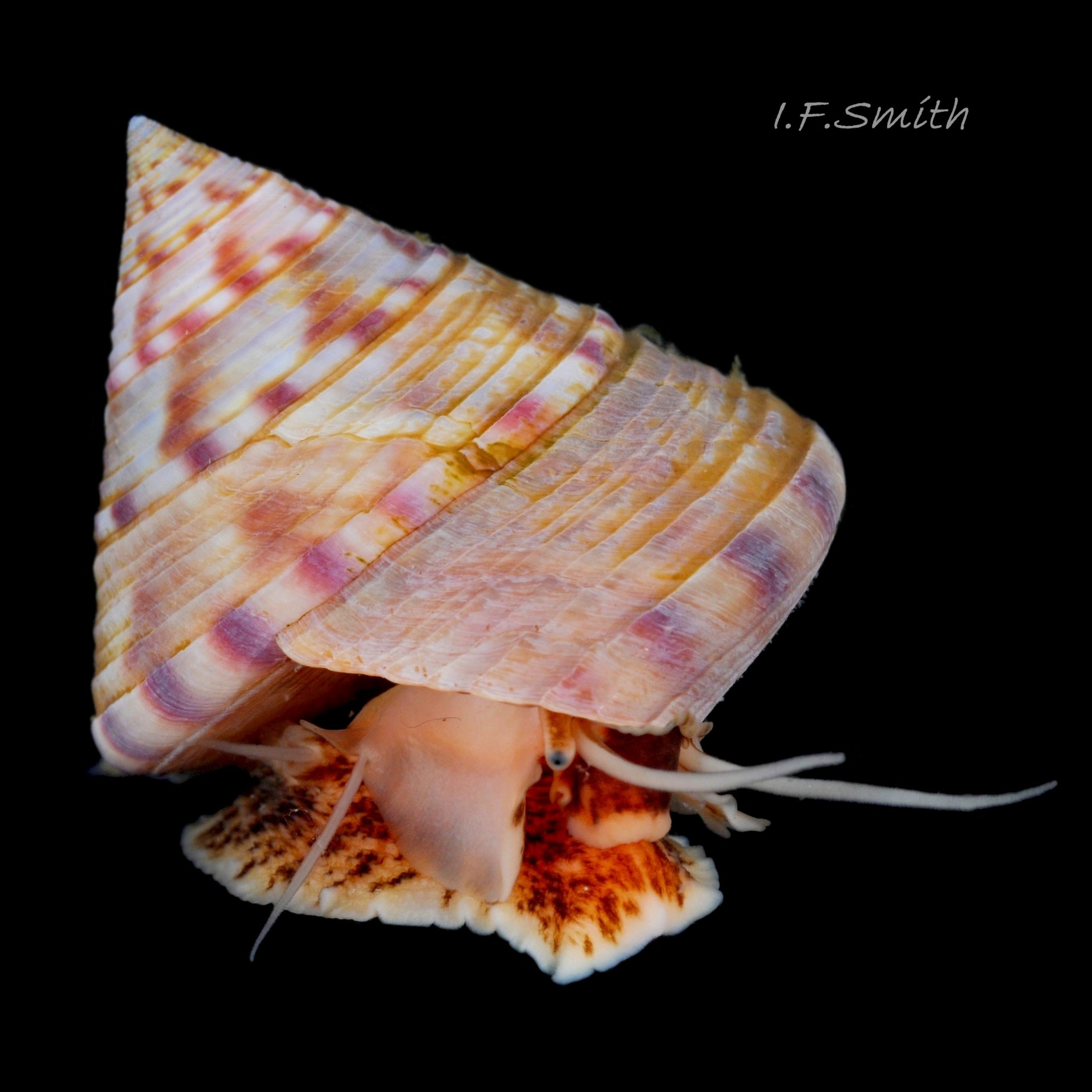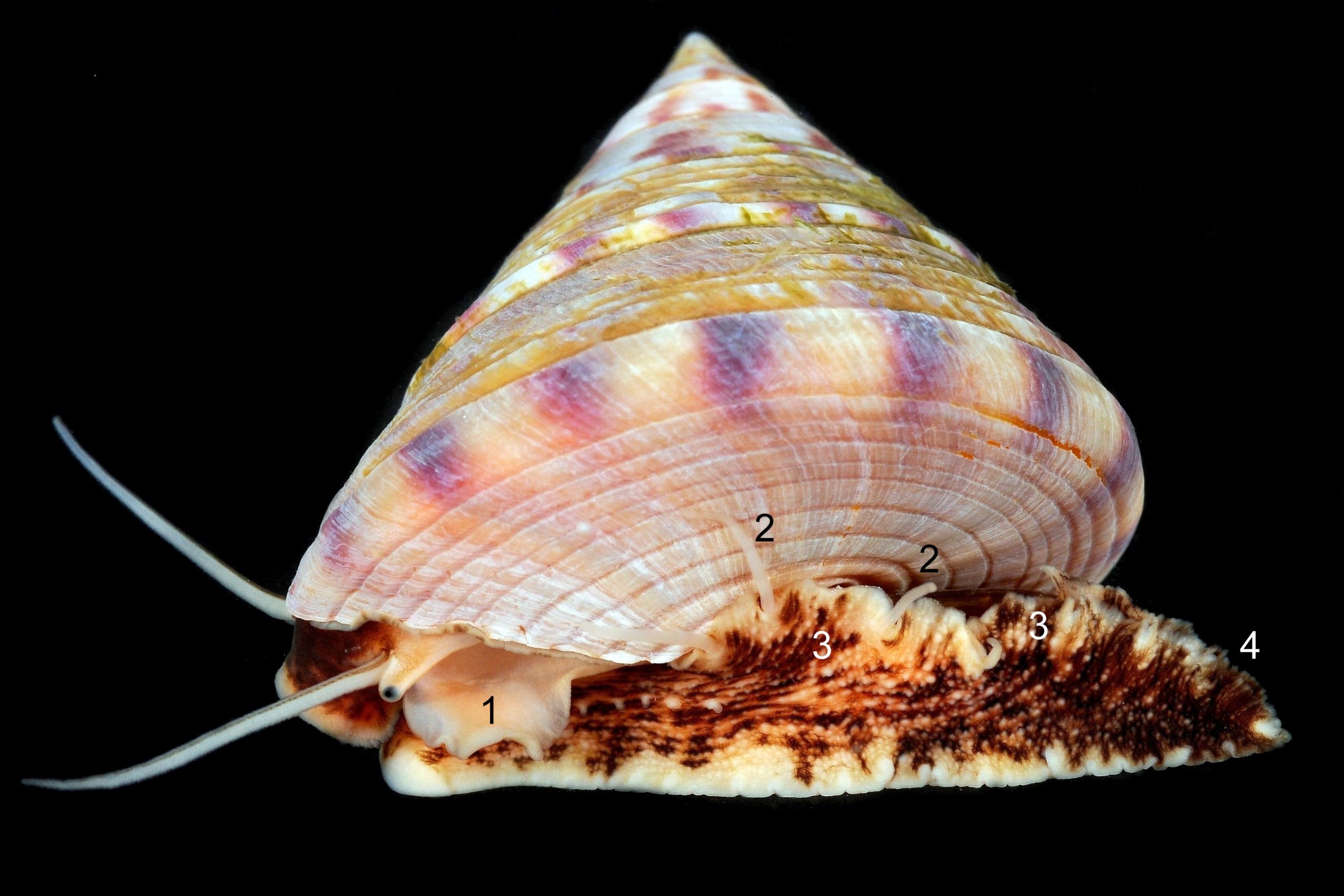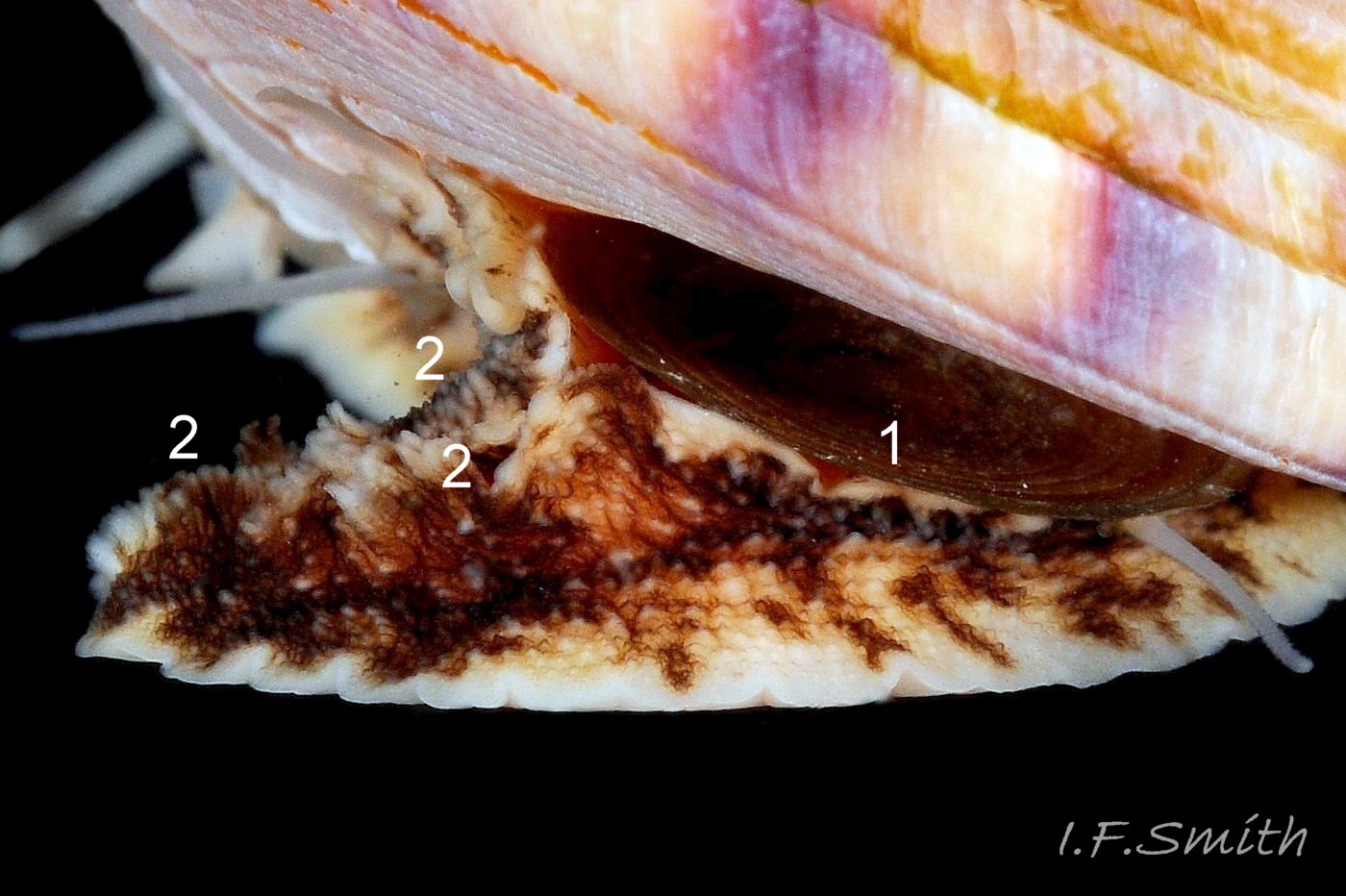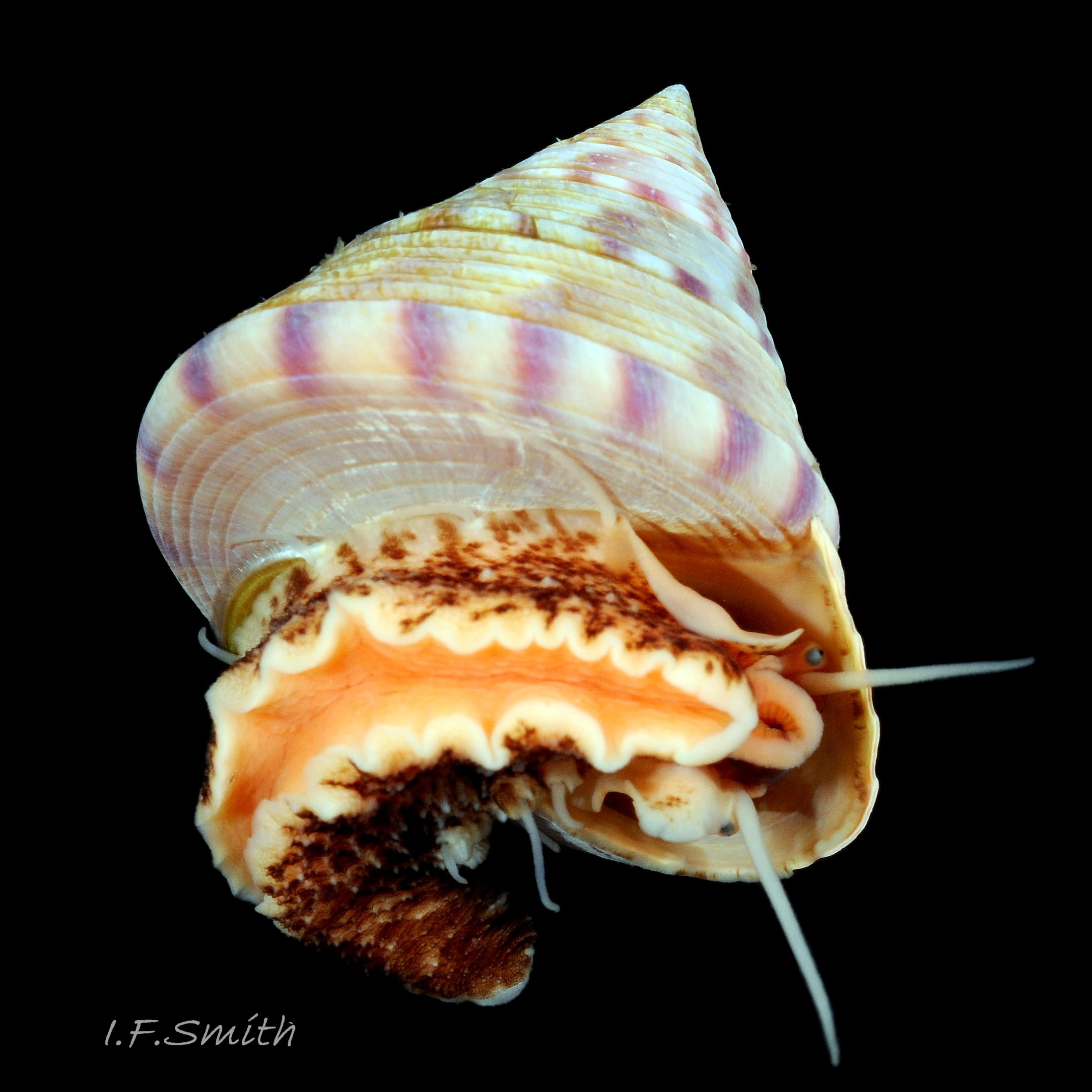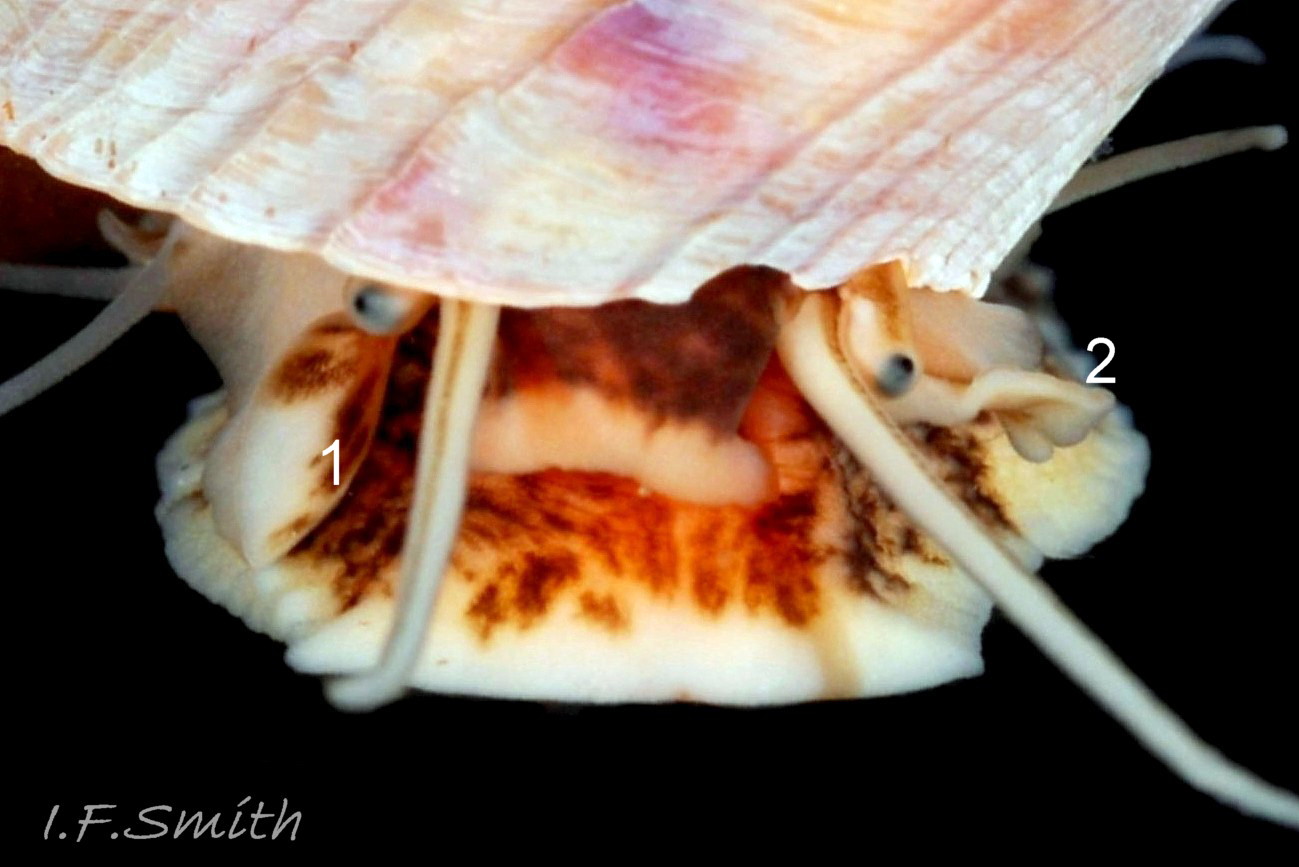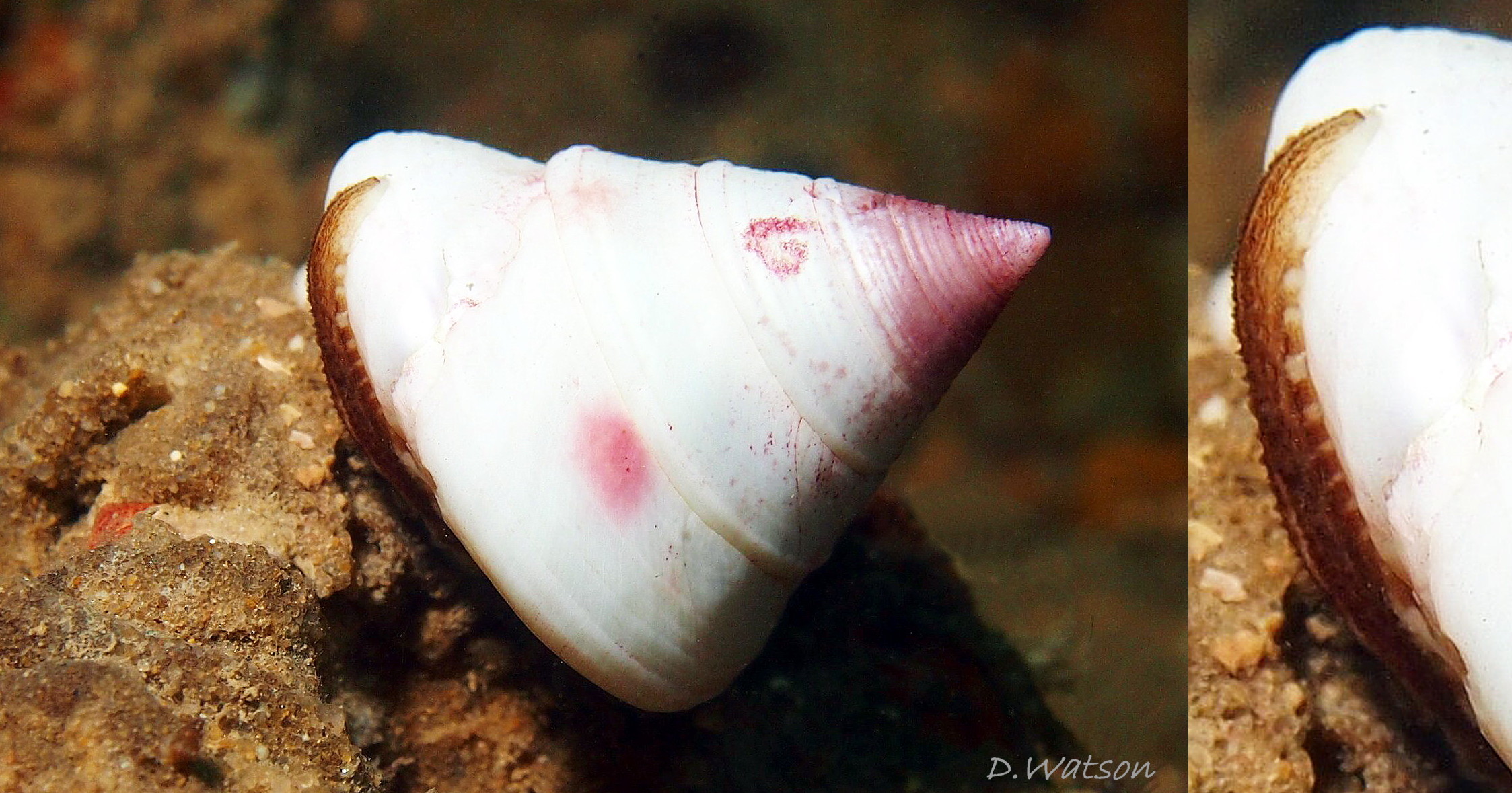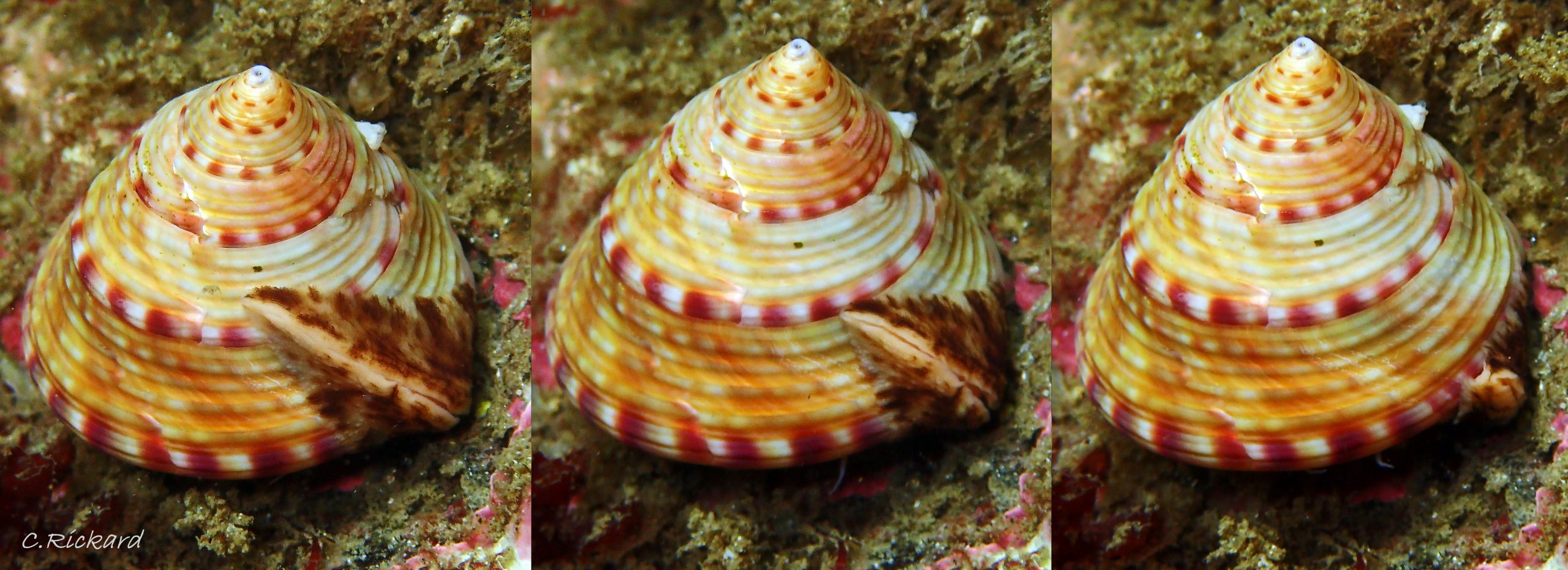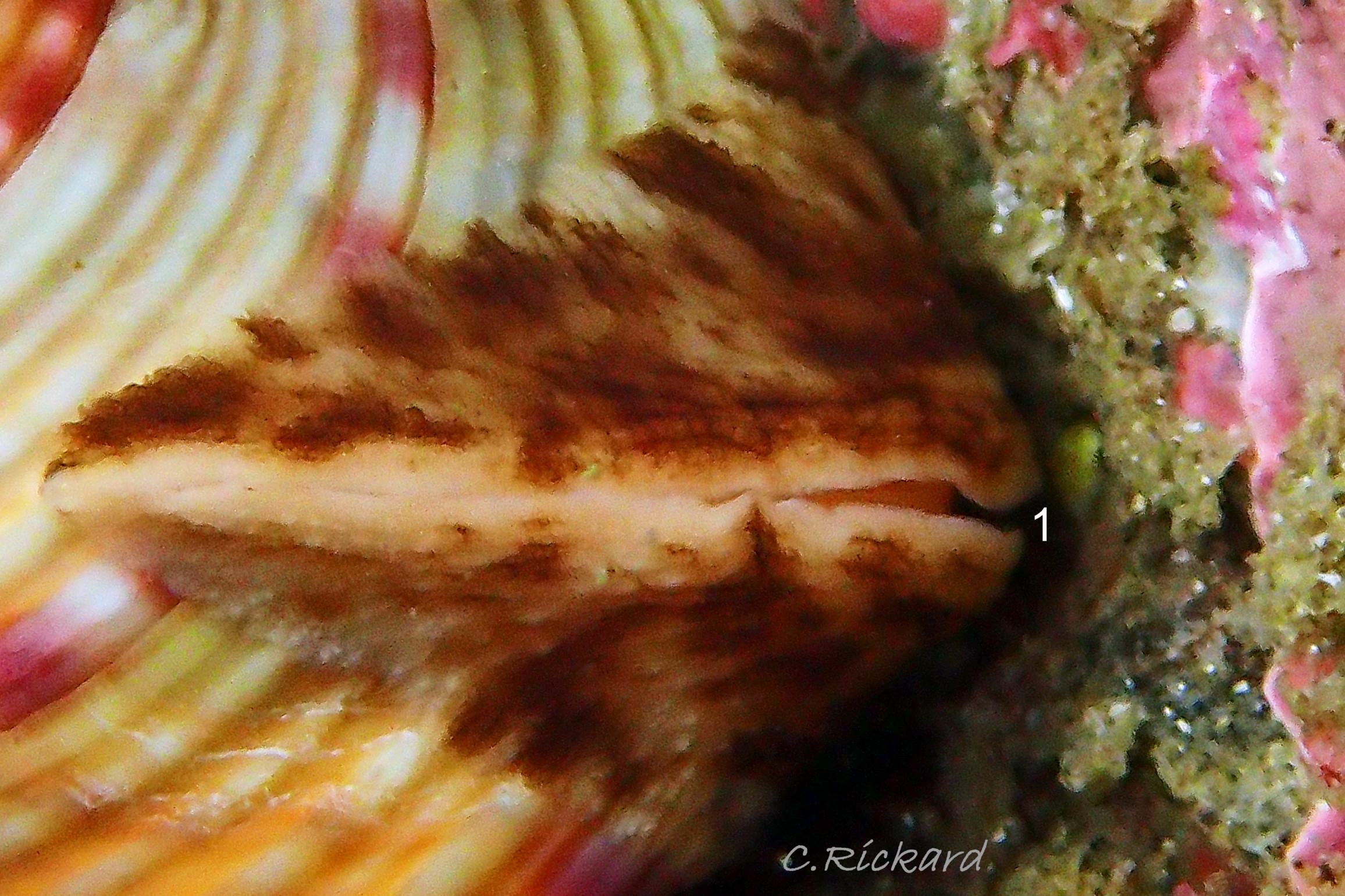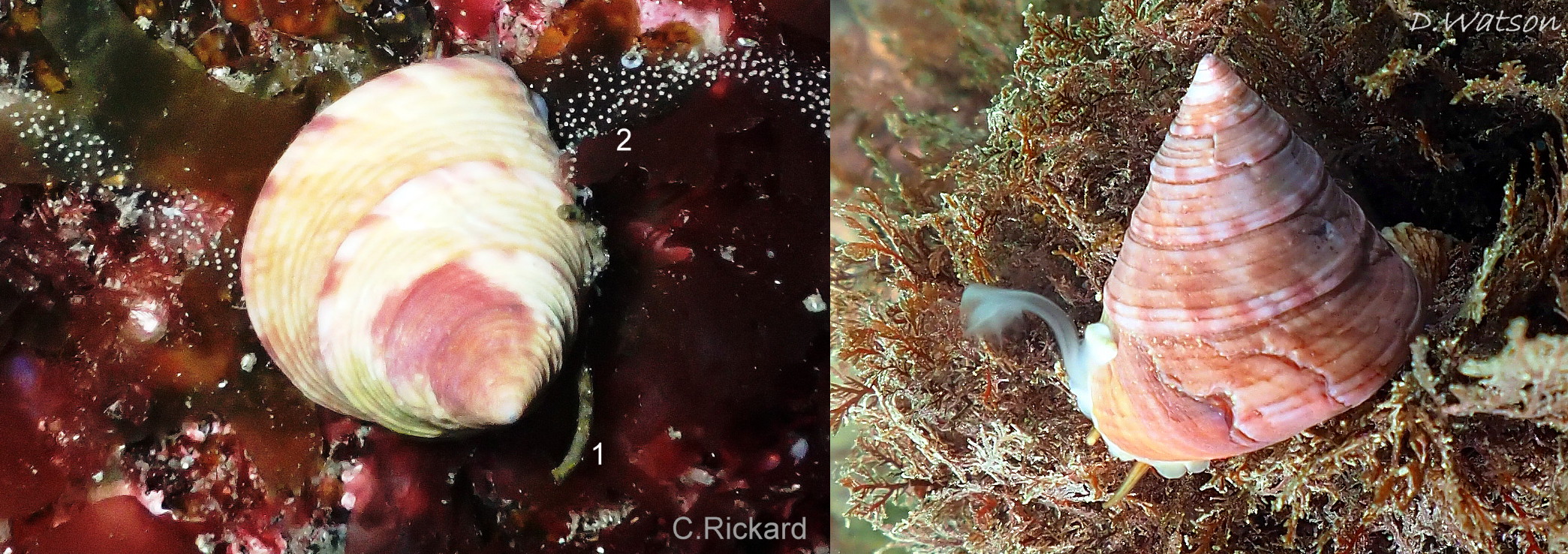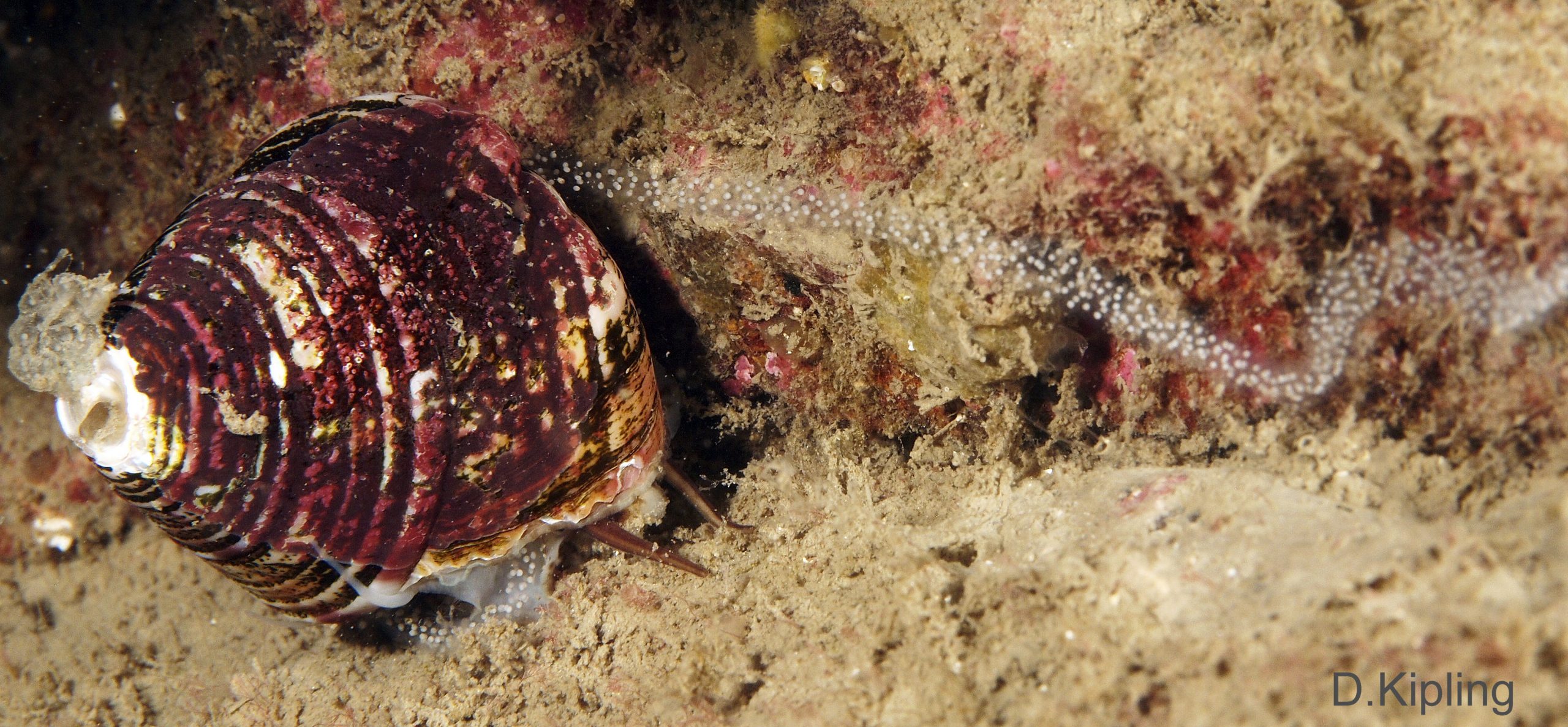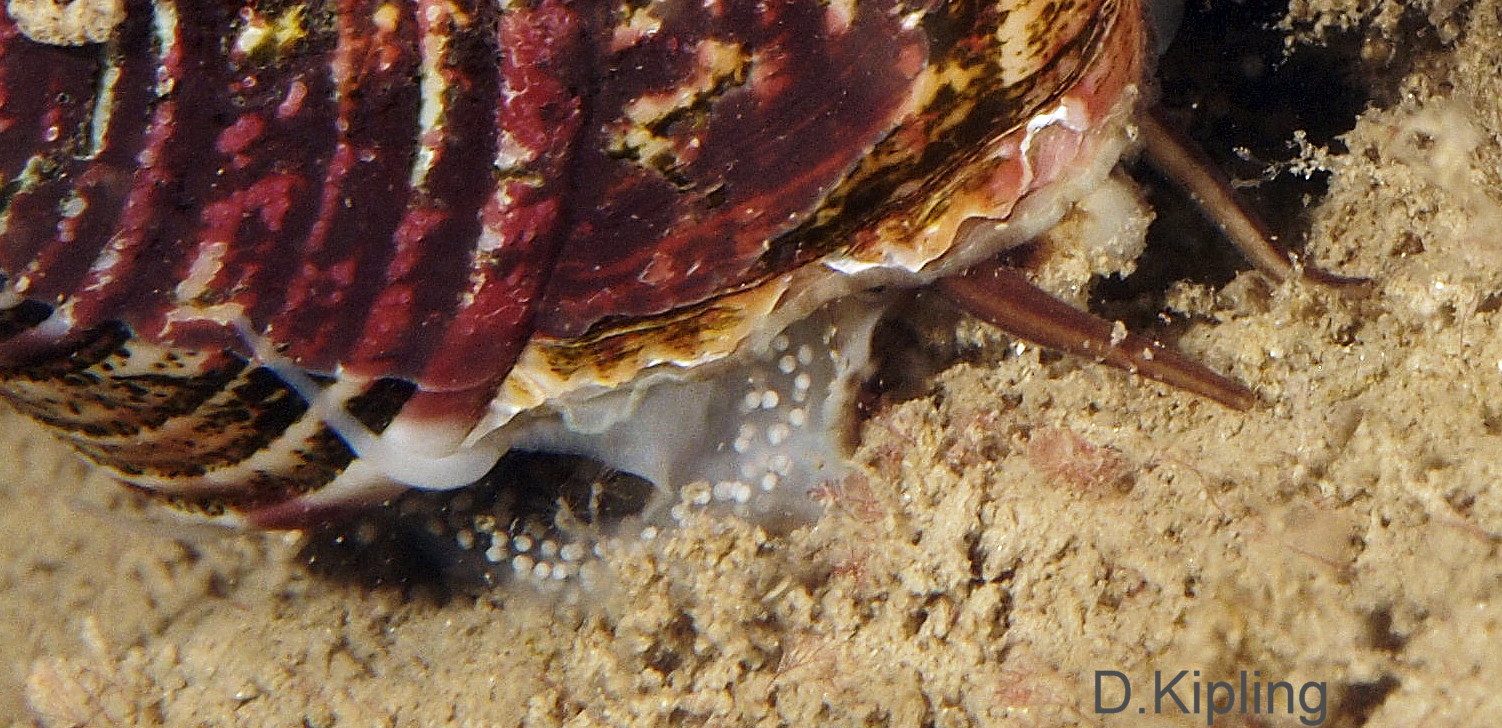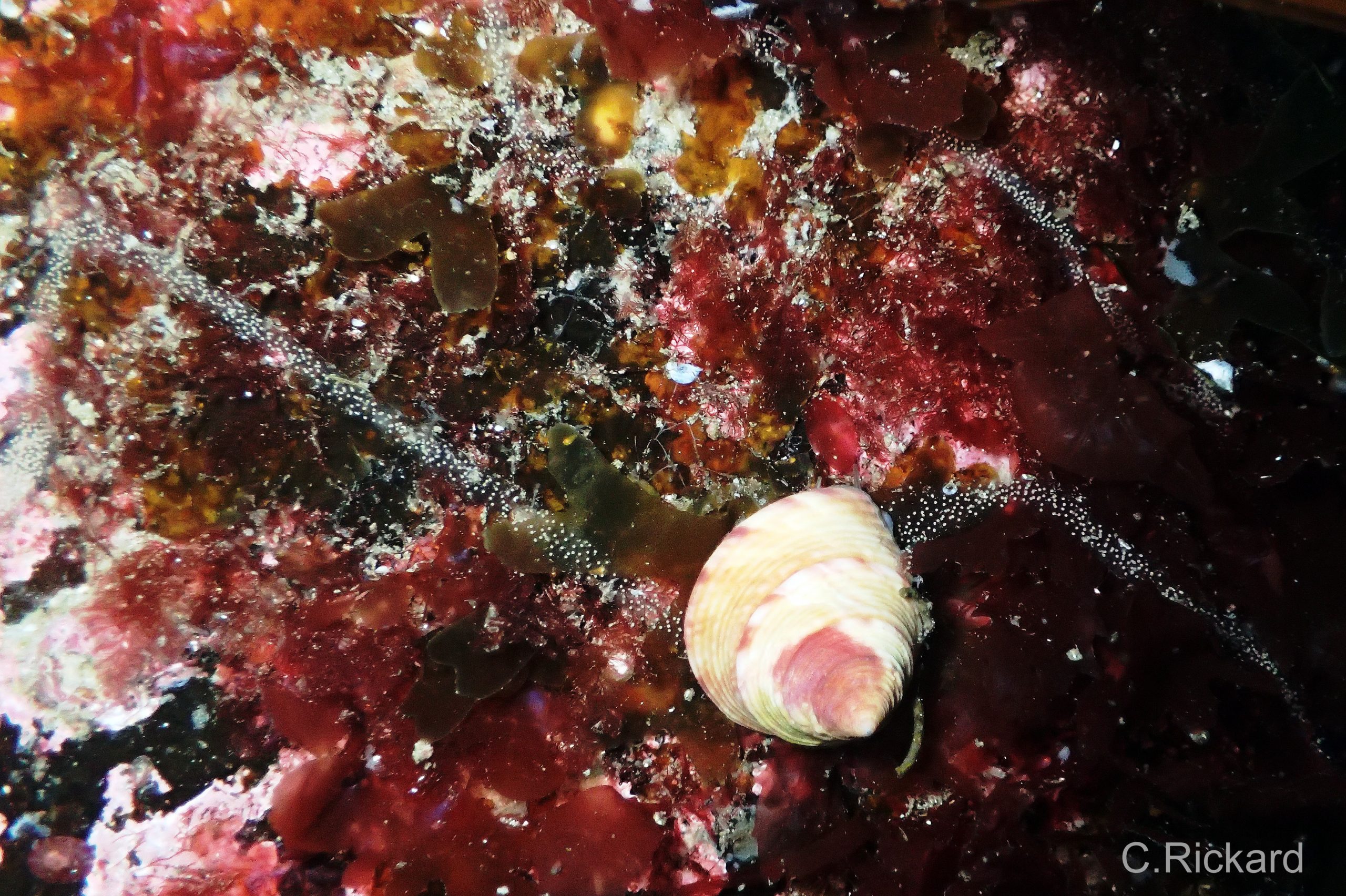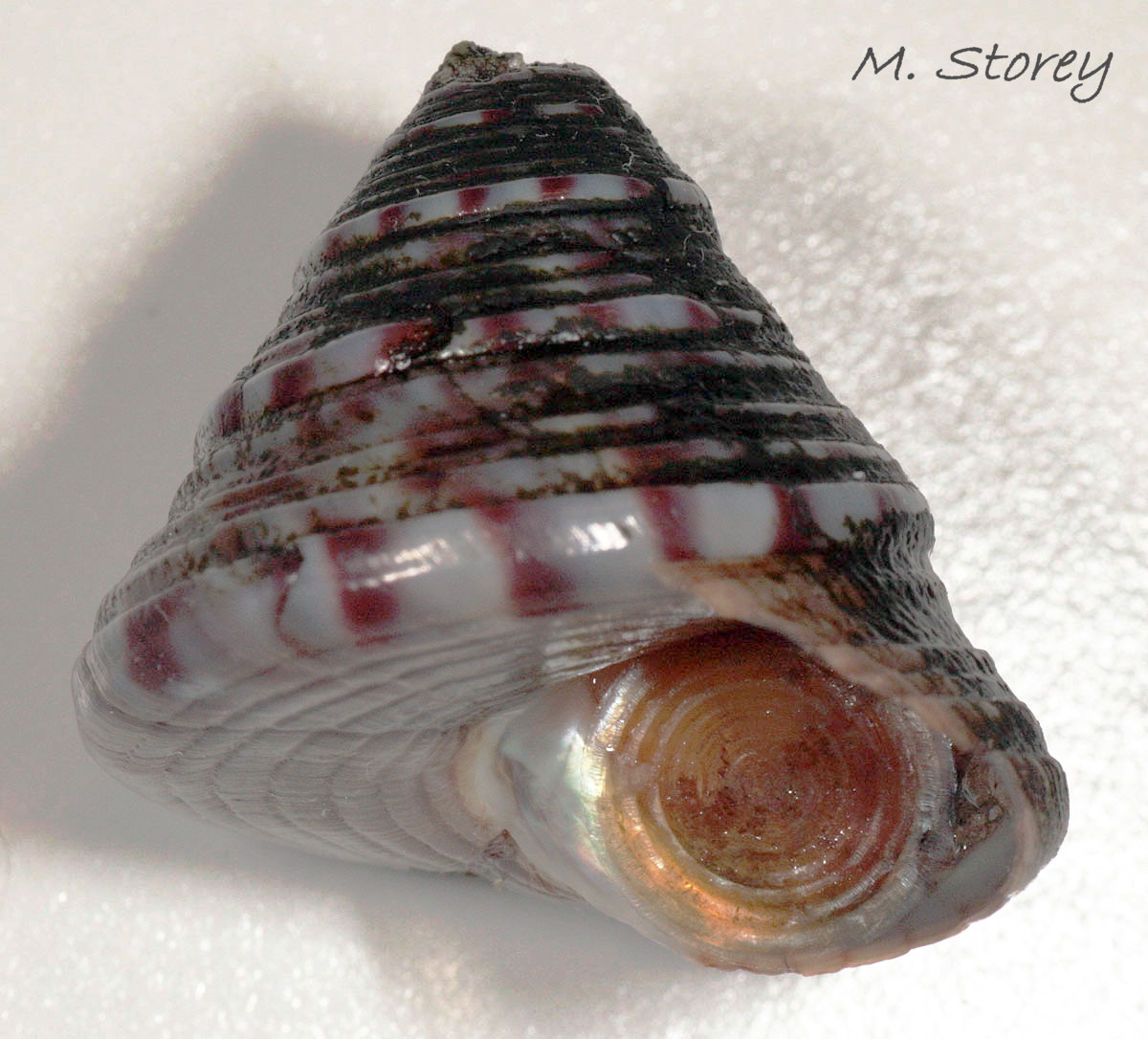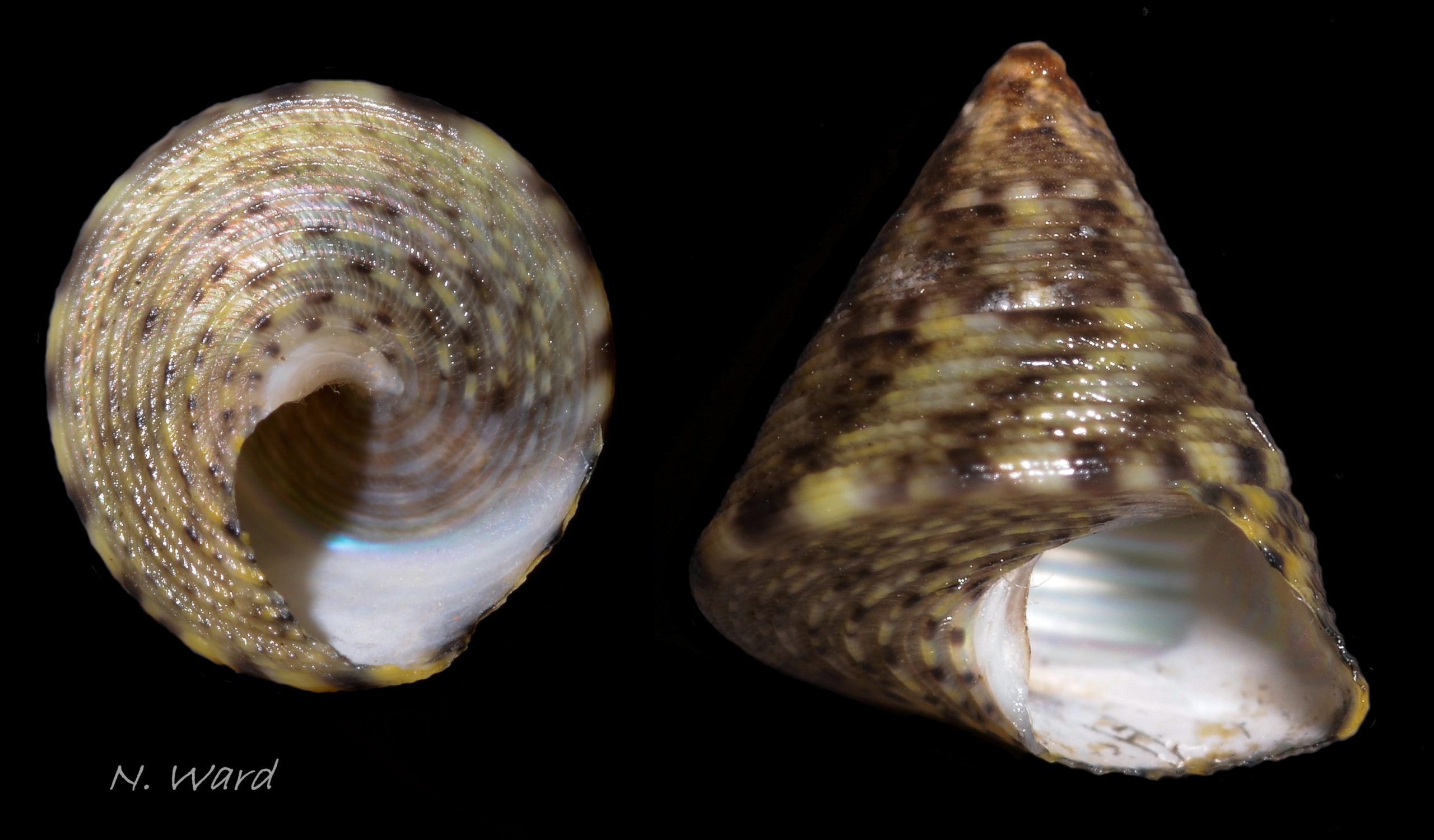Click image to enlarge with full caption. Main text below slider.
Calliostoma zizyphinum (Linnaeus, 1758)
PDF available at www.researchgate.net/publication/348448785_Calliostoma_zi…
Current taxonomy: World Register of Marine Species (WoRMS) www.marinespecies.org/aphia.php?p=taxdetails&id=141767
Synonyms: Trochus zizyphinus Linnaeus, 1758 [in Jeffreys, and Forbes & Hanley]; Trochus conuloides Lamarck, 1822; Calliostoma zizyphinum var. lyonsi (Leach in Forbes & Hanley, 1850).
Vernacular: Painted top shell (English); Trwyn fy nain (Welsh); Plettet topsnegl (Danish); priktolhoren (Dutch); Troque jujube (French).
Meaning of scientific name: Calliostoma (kallos stoma) = beautiful mouth.
zizyphinum (zizyphino) = jujube fruit (colour of).
GLOSSARY below.
Shell description
Maximum width and height are 30 mm; W/H 90-120%. Conoidal, like a traditional spinning top; almost precisely flat sided in profile except sometimes a slight concavity near the apex 01 Calliostoma zizyphinum . The shell is opaque, slightly glossy and slippery. Body whorl height is 40-45% of shell height (Graham 1988) 02 Calliostoma zizyphinum . It is acutely angled at the periphery, the lower part forming a flat base 01 Calliostoma zizyphinum . The sharp apex is rarely eroded on live animals; the apical angle is greater on those living in fast-flowing water. There is a sculpture of about ten incised spiral lines below the angled periphery on the base of the body-whorl, which is hidden on earlier whorls by the subsequent overlapping whorl 02 Calliostoma zizyphinum . Above the periphery, body-whorl has six to nine broad or narrow spiral fillets (bands), the one on the periphery is the largest and broadest 03 Calliostoma zizyphinum . The fillets are separated by grooves. The fillets have curved or sloping abapical edges and steep adapical edges 04 Calliostoma zizyphinum . Fillets above the periphery continue onto the earlier whorls, decreasing in number and clarity; the large peripheral one becomes suprasutural on leaving the body-whorl 03 Calliostoma zizyphinum and remains visible even when other fillets are obscure. Sutures are slight and defined by the suprasutural fillet of each whorl 04 Calliostoma zizyphinum . Most fillets are smooth with very fine transverse striae 03 Calliostoma zizyphinum , but the apical protoconch lacks sculpture and pigment, and fillets on some other adapical whorls are cut into beads 05 Calliostoma zizyphinum so very small young ones are predominantly beaded 20 Calliostoma zizyphinum .
The umbilicus is closed 06 Calliostoma zizyphinum. H. 14 mm. Portland Harbour. April 2012. on all except juveniles less than 7 mm high. The aperture is rhomboidal and wider than high. Its height is c. 33% of the shell height 02 Calliostoma zizyphinum . The parietal lip is a reflected slight glaze on the body whorl. The columellar lip is a wide, white shelf leaning to the left of the axis; sometimes with a slight bulge. The aperture has an obtuse adapical angle. The interior of the shell is coated with pearly white nacre (aragonite crystals), apart from a border just within the outer lip coloured as the exterior of the shell. The ground colour of the shell is whitish 04 Calliostoma zizyphinum , pale yellowish-pink (most often when on granite) and/or peach 04 Calliostoma zizyphinum ; occasionally warm red-brown or pale slate-blue (most often on limestone). Apart from on the all-white variety often found in sheltered rapids, C. zizyphinum lyonsi 06 Calliostoma zizyphinum. H. 14 mm. Portland Harbour. April 2012. , on and above the periphery there are transverse blotches or “flames” of purplish-pink, reddish-pink or dark-liver of varying strength, but usually distinct on the peripheral and suprasutural spiral fillets 04 Calliostoma zizyphinum . Colours match well those of jubjube fruit (zizyphino) jujubetrees.com/ . Even the youngest shells are well pigmented; sometimes small early apical whorls, even on var. lyonsi, are coloured 07 Calliostoma zizyphinum . The circular, polygyrous, spiral, translucent, horn coloured operculum has narrow coils and fine transverse growth lines 08 Calliostoma zizyphinum . Live shells are notable for the absence of growths and deposits, and lack of erosion, but exceptions occur; www.bioimages.org.uk/html/r164639.htm . The thin yellow-brown periostracum is almost always lost from peripheral and suprasutural fillets 03 Calliostoma zizyphinum , and is frequently lost from all or most of shell 10 Calliostoma zizyphinum .
Body description
The flesh is peach-pink to salmon pink or yellowish, heavily marked dark orange-brown 09 Calliostoma zizyphinum (including all-white shell variety, C. zizyphinum lyonsi 10 Calliostoma zizyphinum ) . The orange-peach body of juveniles lacks dark pigment marks 20 Calliostoma zizyphinum . The short snout, is heavily blotched orange-brown dorsally except for the pale tip 11 Calliostoma zizyphinum . There is a small, rudimentary cephalic lappet at the base of each tentacle. The end of the snout is horseshoe-shaped with a wide, peach coloured border surrounding a salmon-pink, crenate-lipped, vertical-slit mouth 12 Calliostoma zizyphinum . The ventral lip has median line with an eversion of the outer lip (pseudoproboscis) on the right (Fretter & Graham, 1962) which is not visible in this set of images. The cephalic tentacles are long, densely setose, whitish or pinkish, with an orange-brown, dorsal median line 11 Calliostoma zizyphinum . There is an eye on a stout peduncle at the base of each cephalic tentacle. A small black exposed part is surrounded by a blue-grey ring of the rest of eye showing through the translucent peduncle 11 Calliostoma zizyphinum . There is a sensory tentacle at the base of the right eye peduncle 11 Calliostoma zizyphinum but not on the left peduncle. There is a large, peach-pink neck-lobe, with orange-brown blotches ventrally, behind each eye. It is often curved to form respiratory part-siphon 13 Calliostoma zizyphinum ; the edge is not fringed on either lobe. The thicker left inhalent lobe undulates and is held out from body to reduce the intake of substrate detritus 19 Calliostoma zizyphinum . The anterior of the foot is truncate, and the posterior is obtusely pointed 13 Calliostoma zizyphinum . When stationary, the foot is often covered by the shell 15 Calliostoma zizyphinum , but the posterior extends beyond shell when in motion 16 Calliostoma zizyphinum . The dorsal and lateral surfaces of the foot are densely covered in papillae arranged in approximate rows obliquely to the perimeter; many are pale yellowish or pinkish and distinct where they protrude through the extensive orange to dark-brown pigment 16 Calliostoma zizyphinum . The periphery of the foot is pale without brown pigment. A large undulate epipodium, coloured and with papillae like the dorsum of the foot, runs along each side of the foot. Each bears four whitish epipodial tentacles 16 Calliostoma zizyphinum & 09 Calliostoma zizyphinum . The whitish opercular disc, to which the operculum is attached, does not enclose any of the operculum edge 17 Calliostoma zizyphinum . The disc is visible as a pale area through the translucent operculum when the animal is retracted into the shell 08 Calliostoma zizyphinum . The epipodia continue on the metapodium behind the operculum, and meet to form a fringed crest concealing a dorsal V-shape area, grooved transversely with abundant mucus-producing cells 17 Calliostoma zizyphinum . The elongate sole, salmon-pink with a peach periphery, 18 Calliostoma zizyphinum , readily folds along a longitudinal furrow 09 Calliostoma zizyphinum . The transverse anterior groove produces mucus for locomotion. The mantle is peach-coloured with brown marks on its edge 12 Calliostoma zizyphinum ; it extends slightly beyond the rim of the aperture 14 Calliostoma zizyphinum . Fertilization is external so there is no penis on males.
Key identification features
Calliostoma zizyphinum
1) Conoidal shell like traditional spinning top; almost precisely flat sided in profile except sometimes a slight concavity near apex 01 Calliostoma zizyphinum . Maximum height and width 30 mm.
2) Spiral fillets smooth with very fine transverse striae 03 Calliostoma zizyphinum . Protoconch lacks sculpture and pigment. Other apical whorls have beads 20 Calliostoma zizyphinum so small young are entirely beaded.
3) Large undulate epipodium on each side of foot bears four whitish epipodial tentacles 16 Calliostoma zizyphinum .
4) Littoral and sublittoral on most coasts of Britain & Ireland, except estuaries and turbid-waters.
Similar species
Jujubinus striatus (Linnaeus, 1758) ( ) 29 Calliostoma zizyphinum COMPARISON Jujubinus striatus
1) Conoidal shell like traditional spinning top; almost precisely flat sided in profile. Maximum height 10 mm and width 8 mm.
2) Shell usually brown with cream or white marks and, on apical area, carmine red. Spiral ribs have variably pronounced nodules.
4) LWST to 200 m depth. Usually found on or near Zostera, Ulva or Codium in Channel Islands, south-west England, Isle of Man and south-west Ireland.
The following beaded/nodose two species have some similarity but are not described here because of uncertainty about the distinguishing features
Calliostoma granulatum (Born, 1778)
Sublittoral, 7-300 m (Graham, 1988). Occasional on gravel and soft substrates in south and west Britain. Maximum height and width 35 mm.
Clelandella miliaris (Brocchi, 1814)
Sublittoral only, 33-800 m (Graham, 1988) On stony substrate. Feeds on alcyonarians and hydroids. Scottish waters and Irish Sea. Maximum height 12 mm, width 11 mm.
Habits and ecology
C. zizyphinum is found under rocks, in crevices and on large algae from MLWS on sheltered shores to 300 m depth. Often on Laminaria but occurs also where there are no large algae. It cannot tolerate exposure to air for long, but it sometimes survives in rock pools on upper shores in northern Scotland on exposed coasts where the summer sun lacks intensity and pool water is frequently refreshed by ocean swell. It favours clean water so, despite an ability to survive salinity down to 21 ppt, NBN distribution maps suggest it is absent from estuaries and turbid coasts such as Liverpool Bay.
Cilia on the undulating left neck-lobe create an inhalent current to the long ctenidium within the mantle cavity 13 Calliostoma zizyphinum . Cilia on the right neck-lobe create an exhalent current for respiratory water, gametes and excreta. Locomotion is caused by ditaxic, direct compression waves on the sole of the foot; turning is caused by different rates of wave flow on either side of the central furrow 18 Calliostoma zizyphinum . It feeds on micro-algae and other micro-organisms brushed by radula from rocks and stones, and about 20% of its food by “shell wiping” (Jones, S.P. et al., 2001). Twice every 24 hours the crest on the metapodium opens 23 Calliostoma zizyphinum to expose a mucus-producing area which is wiped over the shell for about 20 minutes. The coated shell acts like a fly paper trapping micro-organisms and other water borne particles which are ingested along with mucus 21 Calliostoma zizyphinum & 22 Calliostoma zizyphinum This feeding method operates most effectively in strong currents loaded with particles; C. zizyphinum is often large and abundant in marine rapids. Shell wiping usually maintains the shell free of fouling by epibiota or detritus, but not always 28 Calliostoma zizyphinum , and the wiping with mucus is the cause of live shells sometimes feeling slippery. Faeces are irregular rods of sand and calcareous or vegetable detritus embedded in mucus 24 Calliostoma zizyphinum .
C. zizyphinumbreeds in spring and summer in Plymouth, and May to October, with maximum in July, in Roscoff (Fretter & Graham 1962). Spawning at 10º C in natural lighting in captivity was spread randomly across a 30 day experimental period irrespective of lunar phase or time of day (Holmes, 1997). Unlike the trochid Phorcus lineatus and Steromphala spp. which release individual unattached eggs, the female C. zizyphinum lays, indiscriminately over rock and weed, a long, thin spawn-ribbon, 250 to 750mm long by 2 to 5mm wide, attached at one end to the substrate, 25 Calliostoma zizyphinum . The ribbon has up to 700 large ova with mean diameter 0.47mm (Holmes, 1997). It probably expands immediately on contact with seawater in the mantle cavity because it appears fully expanded as it comes into view from the shell 26 Calliostoma zizyphinum . Fertilization is external after the spawn leaves the female. Close proximity of an attendant male during spawning is not required 25 Calliostoma zizyphinum & 27 Calliostoma zizyphinum (D. Kipling and C. Rickard, pers. comm. 2017 and Holmes, 1997). Males in the general vicinity release milky white puffs of sperm and seminal fluid a few minutes after spawning starts and are probably stimulated to action by the release from the spawn of soluble chemicals 24 Calliostoma zizyphinum . The released sperm swim to the spawn, probably in response to material from within the egg mass (Holmes, 1997). Ova have large yolks. Trochophore and veliger stages, passed within the spawn mass, can be seen rotating and then crawling within ova. Young hatch as crawling snails. Unusually for a British trochid, there is no planktonic phase.
Distribution and status
C. zizyphinum occurs from Trondheim, and some offshore islands further north, in Norway to Atlantic Morocco and the Mediterranean. Absent from the Baltic beyond south-west Sweden; scarce or absent from British estuaries and the continental coast of the southern North Sea. GBIF map www.gbif.org/species/2293333 . Lives all round Britain and Ireland where there is suitable hard substrate. U.K. map NBN species.nbnatlas.org/species/NBNSYS0000174273
Acknowledgements
I am most grateful to David Fenwick www.aphotomarine.com , David Kipling, Chris Rickard, Rob Spray, Malcolm Storey www.bioimages.org.uk/ and Dawn Watson for use of their images, and I thank Jon Crothers and Geoff Wigham for help with literature.
Links and references
Forbes, E. & Hanley S. 1849-53. A history of the British mollusca and their shells. vol. 2 (1849), London, van Voorst. (As Trochus zizyphinus) archive.org/details/historyofbritish02forb/page/490/mode/2up
Fretter, V. and Graham, A. 1962. British prosobranch molluscs. London, Ray Society.
Graham, A. 1988. Prosobranch and pyramidellid gastropods. London.
Jeffreys, J.G. 1862-69. British conchology. vol. 3 (1865). London, van Voorst. (As Trochus zizyphinus) archive.org/details/britishconcholog03jeffr/page/330/mode…
Jones, H.D. 1984. Shell cleaning behaviour of Calliostoma zizyphinum. J. Mollus. Stud. 50 (3): 245-247 Abstract: academic.oup.com/mollus/article-abstract/50/3/245/1234573
Jones, S.P., Sturgess C.J., Cherrill, A. & Davies, M.S. 2001. Shell wiping in Calliostoma zizyphinum: the use of pedal mucus as a provendering agent and its contribution to daily energetic requirements. Mar Ecol Prog Ser 212: 171-181. www.int-res.com/articles/meps/212/m212p171.pdf
Current taxonomy: World Register of Marine Species (WoRMS) www.marinespecies.org/aphia.php?p=taxdetails&id=141767
Glossary
adapical = towards the apex of the shell.
aperture = mouth of gastropod shell; outlet for head and foot.
cephalic = (adj.) of or on the head.
cilia = (pl.) linear extensions of membrane used in feeding or locomotion. (“cilium” singular).
columella = solid or hollow axis around which gastropod shell spirals; hidden inside shell, except on final whorl next to lower part of inner lip of aperture where hollow ones may end in an umbilicus or siphonal canal.
columellar = (adj.) of or near central axis of spiral gastropod.
columellar lip – lower (abapical) part of inner lip of aperture.
conoidal = nearly conical.
ctenidium = comb-like molluscan gill; usually an axis with a row of filaments either side.
ditaxic = (of locomotion waves on foot) double series of waves, out of phase with each other,
direct = (of locomotion waves on foot) waves travel from posterior to anterior.
ELWS = extreme low water spring tide (usually near March and September equinoxes).
epipodial = (adj.) of the epipodium.
epipodium = collar around sides of foot of some gastropods, often bearing epipodial tentacles.
height = (of gastropod shells) distance from apex of spire to base of aperture.
mantle = sheet of tissue that secretes the shell and forms a cavity for the gill.
MLWS = mean low water spring tide level (mean level reached by lowest low tides for a few days every fortnight; Laminaria or Coralline zone on rocky coasts).
opercular = (adj.) of the operculum.
opercular disc = part of foot that is attached to the operculum.
operculum = plate of horny conchiolin used to close shell aperture.
periostracum = thin horny layer of chitinous material often coating shells.
plankton = animals and plants that drift in pelagic zone (main body of water).
retrograde = (of locomotion waves on foot) waves travel from anterior to posterior.
suprasutural = (adj.) above (adapical of) the suture.
suture = groove or line where whorls of gastropod shell adjoin.
trochophore = spherical or pear-shaped larvae that swim with aid of girdle of cilia. Stage preceding veliger, passed within gastropod egg in most spp., including C. zizyphinum, but free in plankton for most Trochidae.
umbilicus = cavity up axis of some gastropods, open as a hole or chink on base of shell.
veliger = shelled larva of marine gastropod which swims by beating cilia of a velum (bilobed flap). Stage passed within egg of C. zizyphinum.
